
Over the past two days, a small number of publications have gotten a hands-on look at the Garmin Vector system – which starts shipping today (Wednesday, August 7th). In doing so we’ve collectively been able to ride with it, ask any questions we wanted of the Vector development team, and poke at it as we’ve seen fit. But an in-depth review that does not make. That takes time, specifically, lots of riding time with lots of comparative power meters at once.
Typically I dedicate at least 30-45 days for power-meter related reviews for data gathering. That’s not so much a function of total days, but really riding time in between my busy work travel schedule. Luckily, I’m off for a few weeks, so I have more time to ride than normal. But that still means lots of riding time. Which is all a long round-about way of saying this isn’t an ‘In-Depth Review’, instead, it’s just an initial hands-on look at the platform. I’m aiming for a review in early September – likely in between Eurobike and Interbike, barring any major issues.
Upon leaving this event, the six media organizations present were handed production trial units to use and test with. Once that trial is complete I’ll be sending it back to Garmin. The units were production units off the assembly line like any other unit, they were/are not beta, and are final build. The same units that you’ll be able to procure starting today.
What I’ve noted below is a culmination of these past two days, as well as the past 2+ long years of technical conversations with the Garmin Vector team. But, ultimately, these handful of rides are just the start of a longer in-depth review process to understand whether the $1,699 power meter is worth your hard earned cash.
So, with that bit of of warning out of the way, let’s dive right into things:
What’s included inside the box:
Unless you’ve got yours secondhand from some guy on the street corner, you’ll start with the Vector systems in the box – like so:

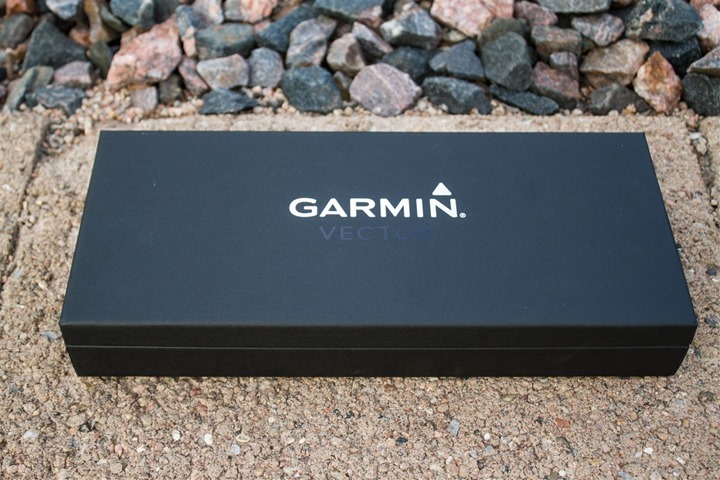
Cracking open the lid we find all the major components looking up at us:
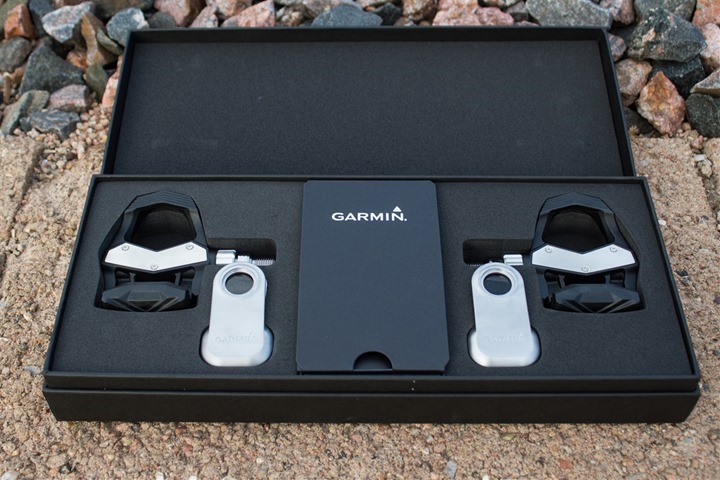
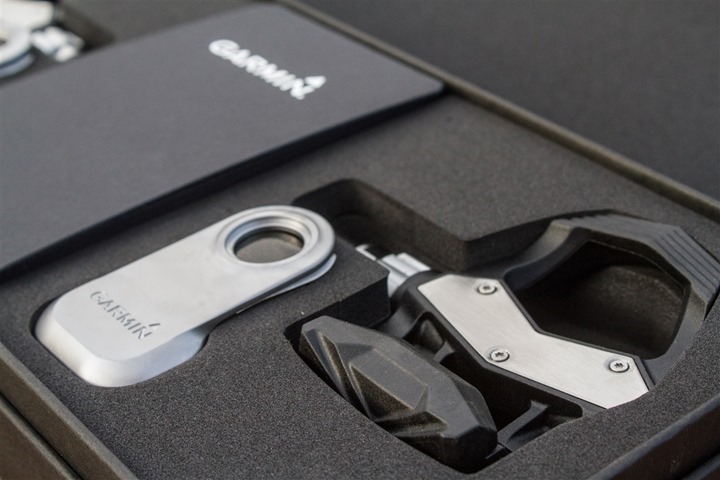
If we open up that middle compartment there’s a small pile of paper goods, along with a pair of cleats, some washers, and a USB stick:
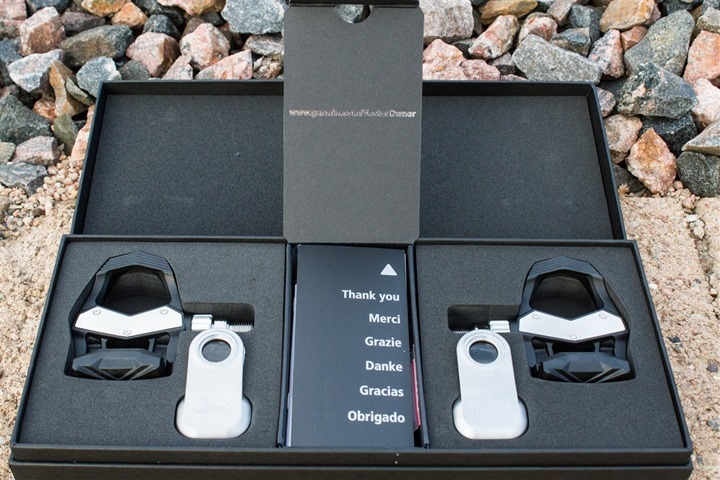
Here’s what that all looks like when unpacked:
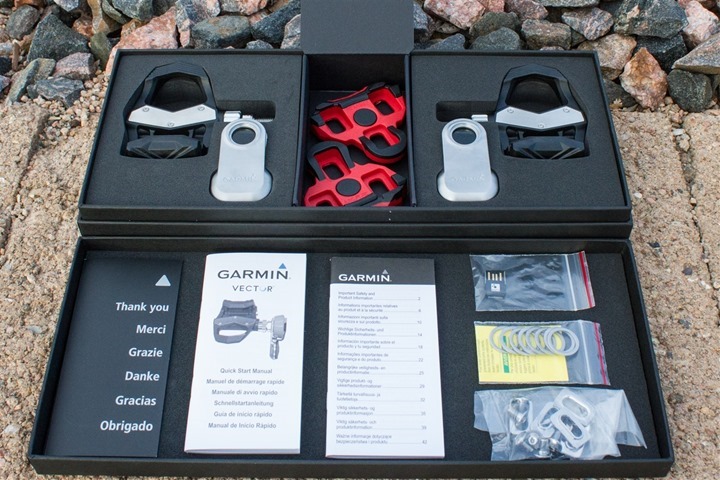
Next we’ve got what are really the two major components of Vector: The pedals and the “pedal pods”.
The pedal pods contain the communications components, effectively the ANT+ radios. There is no official left or right. Instead, that’s dictated by the pedals.
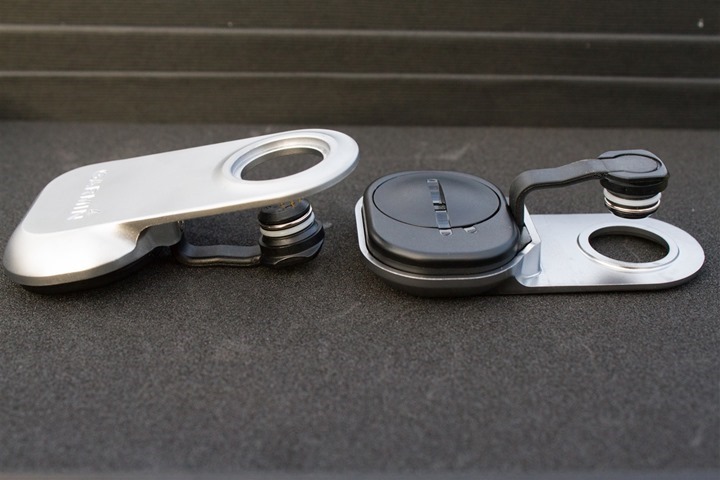
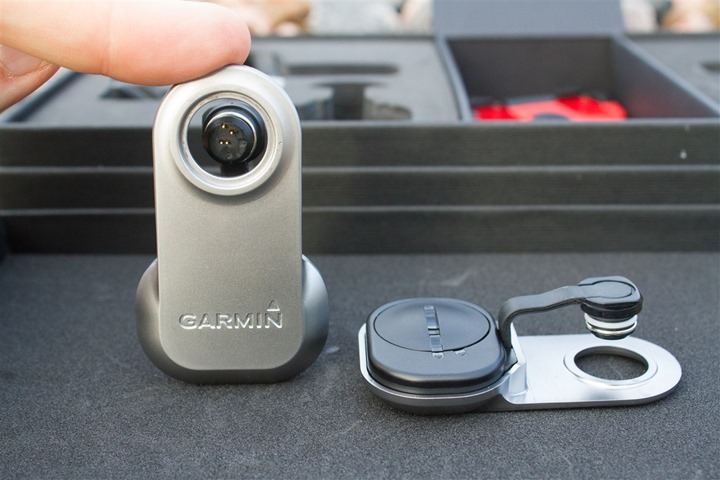
Next up is the pedals themselves. The pedals actually contain three components: The pedal body, the pedal cartridge (goes in the body), and then the pedal spindle (goes in the cartridge). The spindle is the piece that ultimately measures the load you exert. The pedal body is a LOOK Keo compatible unit:
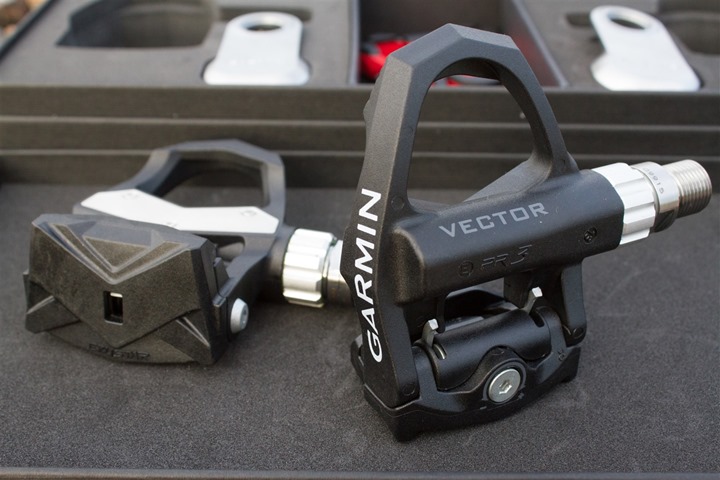
The pedal body and pedal cartridge are manufactured by Exustar, whereas all remaining components are made in-house by Garmin (or a component supplier). Ultimately, everything is tested as a single system upon assembly in Taiwan. In fact, every Vector set is individually dynamically calibrated (meaning with rotating weights by a computer) before shipment.
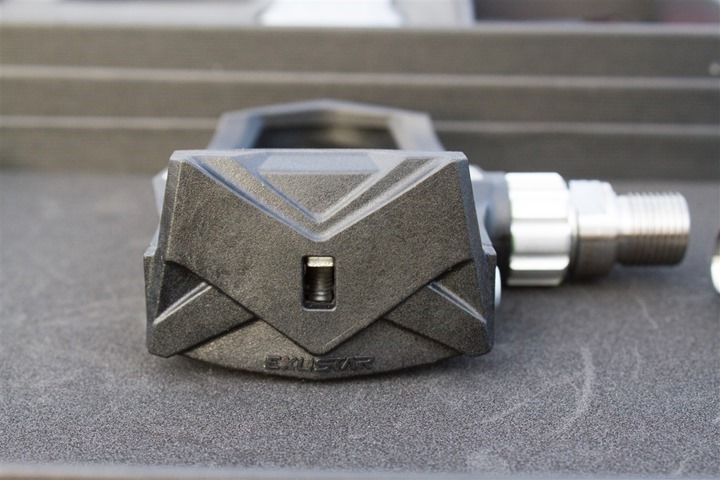
The calibration values are recorded into the device at time of manufacture. Additionally, a multi-point temperature calibration is done at the factory as well prior to shipment. Since silicon strain gauges are known to have repeatable temperature drift properties, by doing a multi-point temperature calibration they can ensure temperature shifts don’t impact accuracy (the pedals have temperature gauges in them).
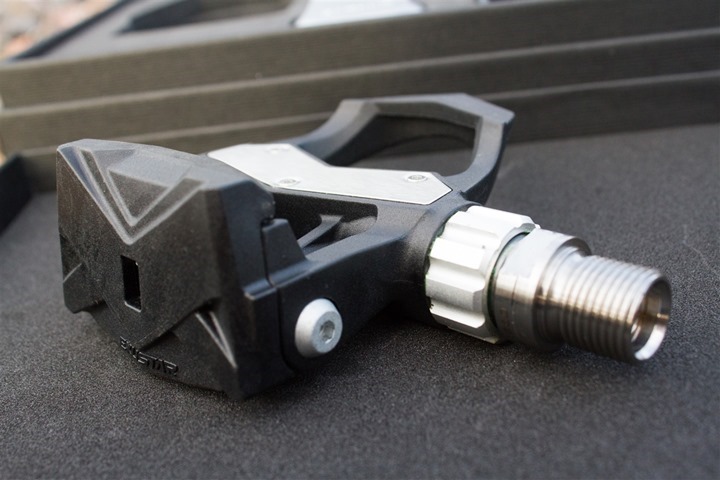
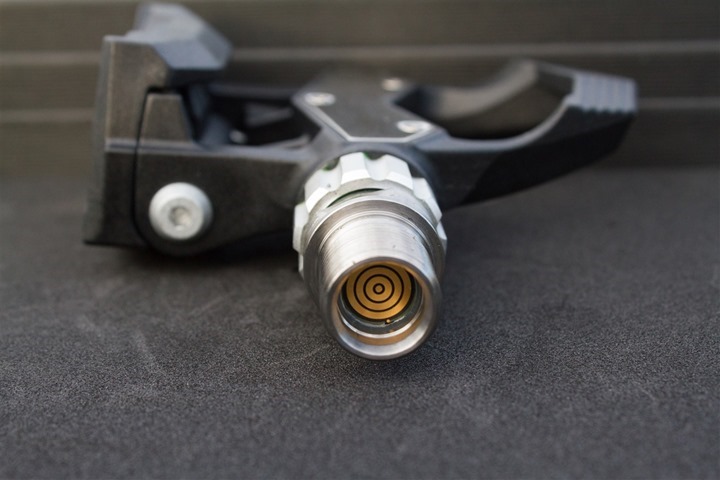
The pedal type is perhaps the single most controversial aspect of Vector. Initially in the Metrigear days pre-Garmin it started off life as a Speedplay pedal, but post-acquisition it changed to being a LOOK Keo compatible pedal. The reason for this is primarily business focused. They discussed the need to be able to effectively ‘own’ the process end to end from design to support – with them saying that “we wanted to own the spindle, and own the supply to the spindle.”
Which isn’t to say that other pedals aren’t being considered. Garmin Vector lead Clark Foy noted that “Nothing technical prevents us from doing that [other pedal types], it’s a pure business decision.”
In fact, they commented that every pedal vendor has contacted them about offering a Vector-compatible unit. And no doubt in time they’ll be offering more pedal types. They believe that the next market for them will be mountain bike pedals, and then they’ve also expressed an interest in looking at spin bikes as well.
Finally, the weight of the pedals are as follows (per pedal):
Pedal (including cartridge/spindle): 152g
Pedal Pod: 23g
Cleats and hardware (screws): 38g
Total per pedal: 213g
Getting it installed on your bike:
Now that we’ve got it unboxed, we’ll go ahead and get everything installed. The entire process only takes a couple of minutes and is pretty straight forward.
First, I’m going to assume that you’ve removed your old pedals. Additionally, I’m going to assume you were able to install the cleats (if needed) on your bike shoes.

With that out of the way, we’re ready to begin. The first thing we’ll need to do is determine whether or not any of the washers are needed. Washers are used within the crank arms to allow for a tighter fit. While that may seem contradictory to add width to increase fit, it ensures that the system can be ‘pulled tightly together’.
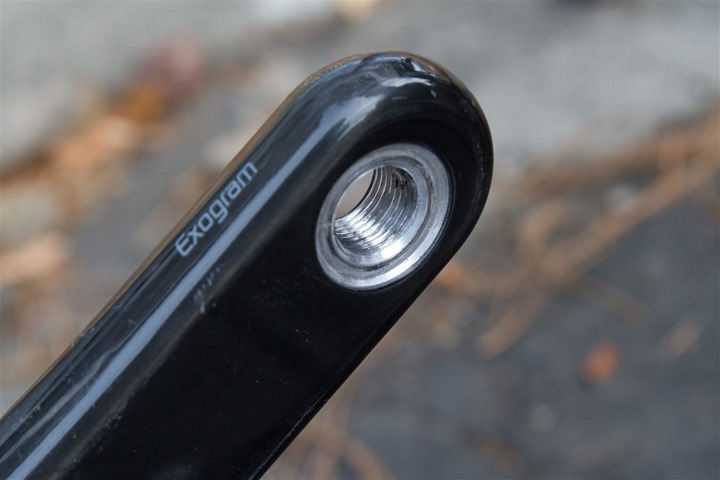
In my case we ended up going with two washers, but that’ll vary per crank arm brand/model. The Vector team recommended that you err on the side of more washers rather than less washers. The reason being you really want things to be absolutely snug and tight.
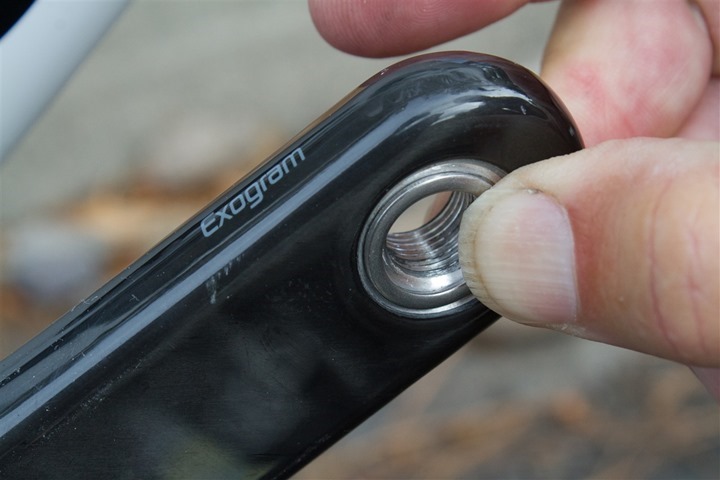
You can see below there’s a bit of a gap between the crank-arm and the pedal pod. This is actually good. If there was no gap, they’d actually be concerned, as that’s a sign that things might not be tight.
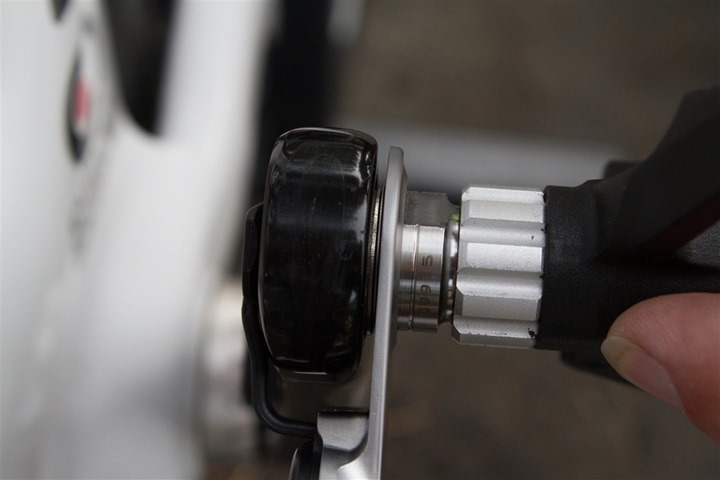
Next we’ll go ahead and slide the pedal pod onto the crank arm. The pedal pods have no specific left/right. They play with whomever. The pedals themselves control left/right. So you can mix and match the pods with no consequence.
Now we’ll add the pedals in. Do this with the crank-arms horizontal (9PM/3PM position). As an installation tip, when you get pretty close to really tightening things down, you’ll want to actually angle the pod slightly forward. That way when you fully tighten things it naturally tightens into the vertical position.
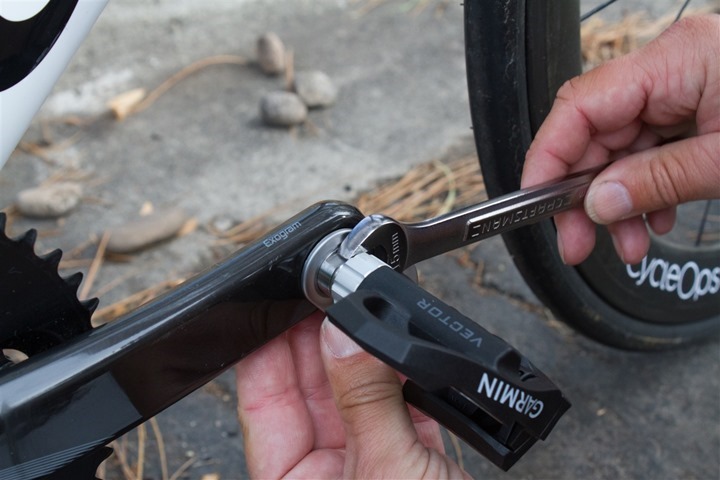
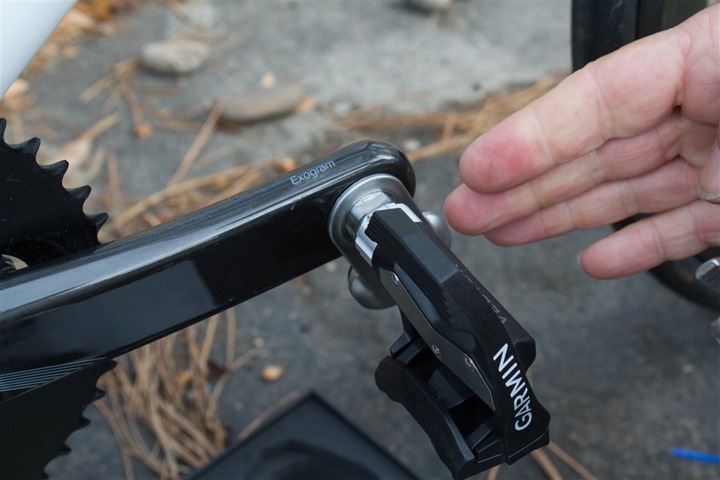
Which brings me to the next point. You can arrange the pedal pod in any orientation that you want. But the Vector team strongly recommends the angle shown below (pointing down while on the forwarding horizontal position). The reason being that if you were to orient the pod upwards instead (for example), you could potentially hit it with your shoe when you clip in/out.

Many folks have expressed concern about the pedal pods hitting the ground. That’s actually a bit of an optical illusion, it’s actually virtually impossible to hit the pedal pod without hitting your shoe first. They note that in thousands of hours of testing they’ve never had a single pedal pod break-off by hitting the ground.

Here’s a bit more of a zoomed in look at the same photo. Note that in this case, the crank-arm is pointed directly down (the photo angle makes it appear otherwise). You can see that it’s technically impossible to hit the pedal pod at that angle.
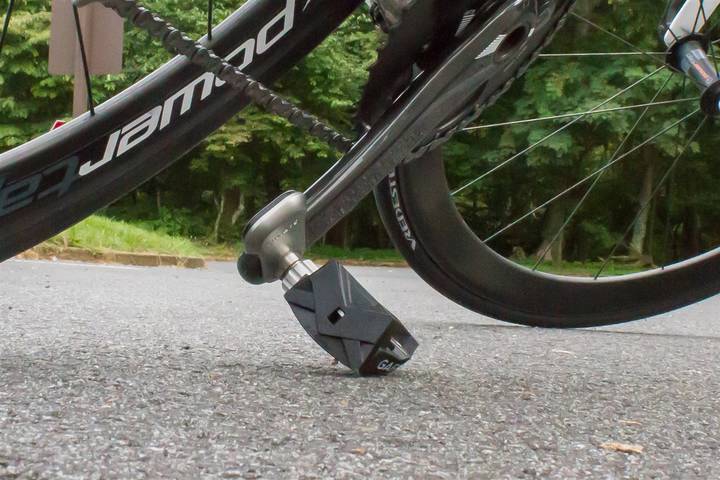
Now, curbs are potentially another scenario entirely, as seen below:
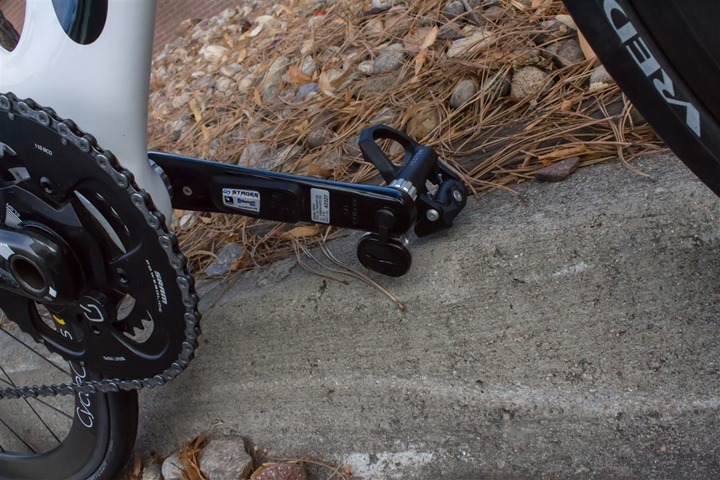
When it comes to mountain bike pedals (in the future) – that’s definitely an area the Vector team recognizes they’ll need to address.
Getting back to the installation, you’ll go ahead and complete the process on the opposite side. Also, you’ll want to snap in the pedal pod cable. Once that’s done it’s time to pair it with your bike computer.
By default the unit will now be in a pairing mode (they call it beacon mode). But in the event you want to manually pair it with the ANT+ ID, it’s actually laser etched into both pedals (09915):
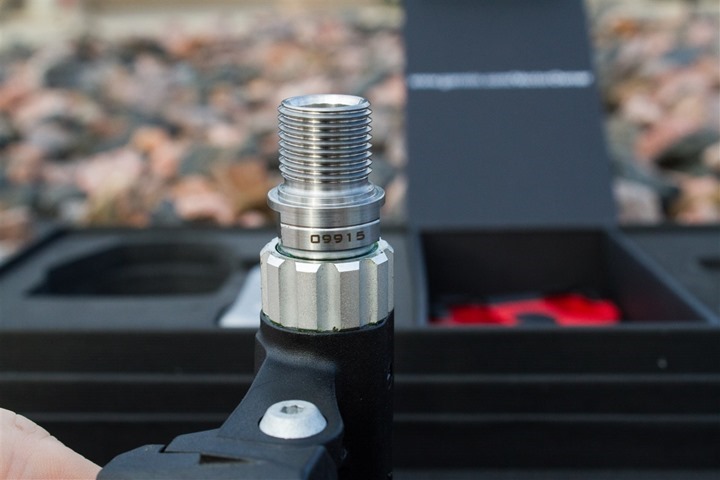
Which, brings me to another notable. The pedals themselves are paired to each other in the factory. This can’t be changed (in other words, you can’t mix half a pedal with a friend, or split pedals with a friend). The right pedal acts as the master (primary), and the left pedal acts as the secondary. Data is communicated from the left pedal to the right pedal via a private ANT channel, then broadcast via ANT+ by the right pedal to your head unit (using standard ANT+ power messages).
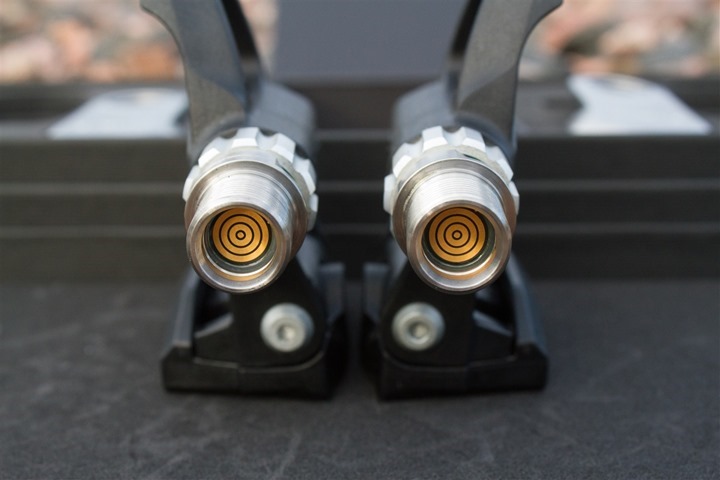
After pairing your pedals within the bike computer you’ll need to go ahead and enter your crank length. This is required for accurate measurement of data. By default it’ll be set at 172.5mm. In the event you don’t have a head unit that you can set crank length with, you can do so via the Vector Updater app that you can download from the site (PC/Mac). I show a bit of that towards the end in the firmware update section.
With the crank length set you’ll need to get on the bike and ride (trainer or forward movement) at 80-90RPM’s for about 5-7 seconds. It’s super-quick and easy. This is called “Setting the Installation Angles”. On the Edge 510/810, there’s a small wizard that walks you through this:

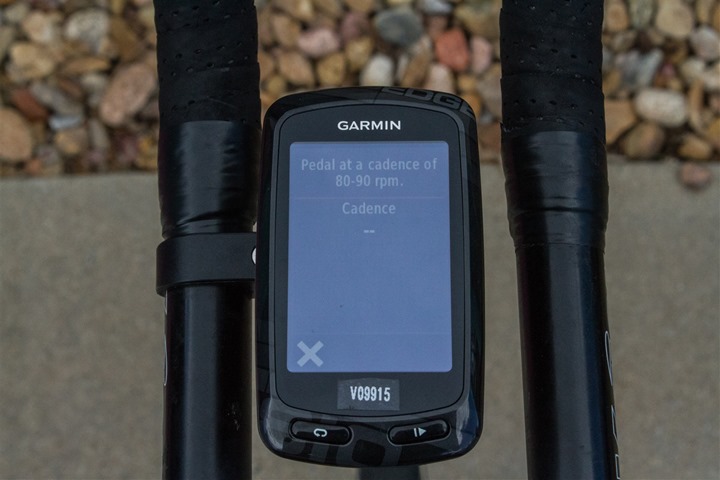
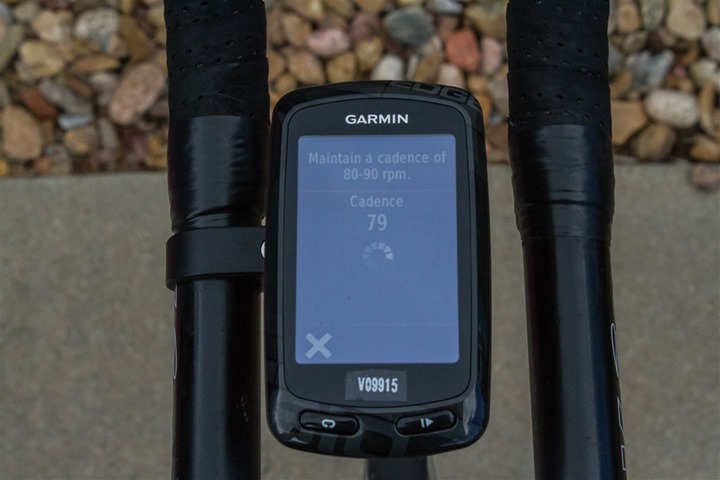

For those without the Edge 510/810, you can just do this manually – simply go and ride for 15-30 seconds. The Vector unit will internally set the installation angles and start transmitting power. It’s really important to note that you won’t see wattage data until this completes.
Once that’s complete, clip out of your pedals and stand over the bike (or next to it). Then do a manual calibration (Static Calibration). You’ll access this through the bike profiles, and then the power settings.
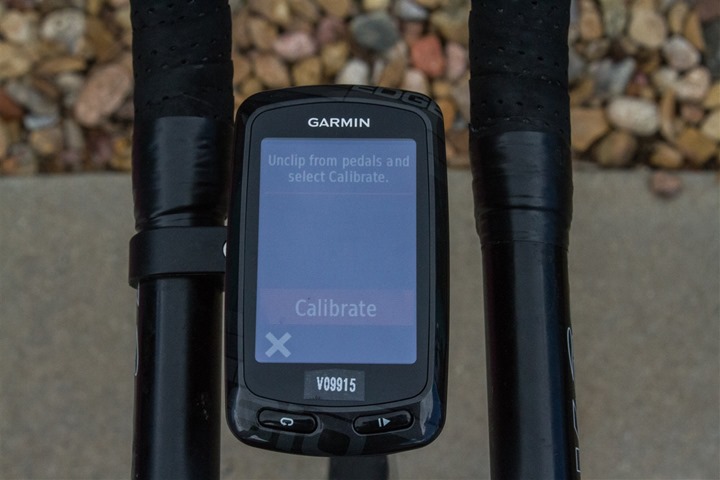
This takes about 10 seconds to complete:
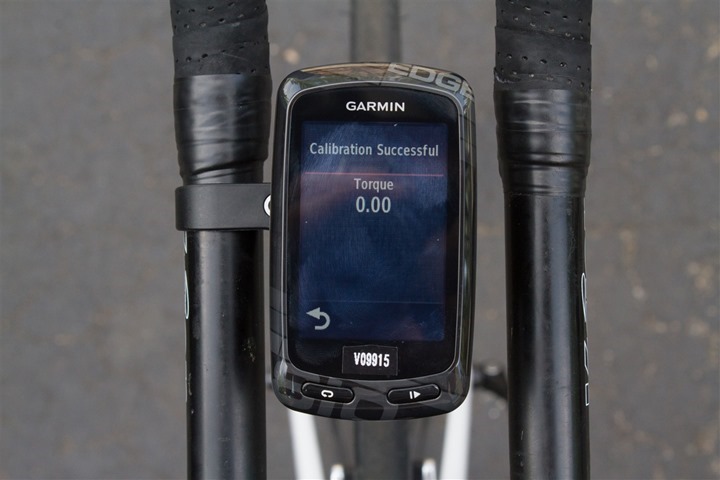
Finally, get back on the bike and start your ride. At this point do what’s called a “Dynamic Calibration”, which is simply pedaling backwards 8 times. Upon the eighth time you’ll receive a Dynamic Calibration confirmation message.
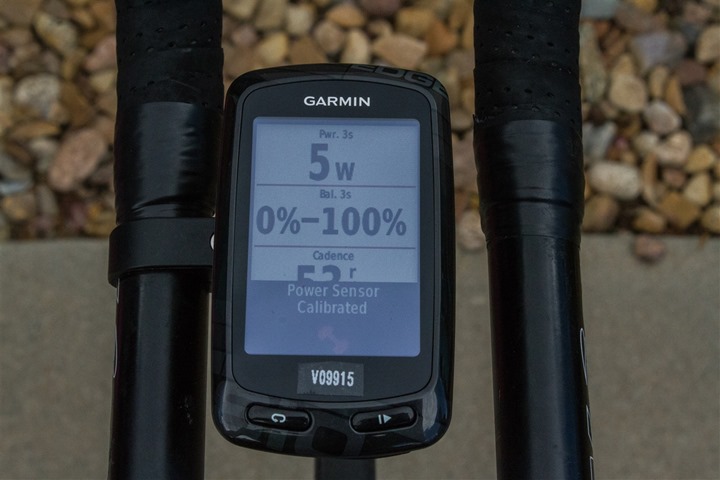
With that, you’re good to go! You should always do these last two steps at the start of every ride (just like any other power meter on the market).
Quick Checklist: With your installation largely complete, here’s a quick checklist I’ve put together for ensuring you’ve taken care of everything:
1) Washer in place if need be, more is better than flush/less.
2) Pedals tightened to 25 foot-pounds (ft-lb). Too little or too much can result in inaccurate power. If you firmly tighten with a wrench, you will be fine. Just don’t under tighten (e.g. finger tighten) or put your full force into tightening the pedals.
3) Pedal connectors plugged into pedals.
4) Pair pedals within the bike profiles. Ensure that your crank length is correct (i.e. 172.5mm, 175mm, etc..). If on older Garmin, use computer instead to do this.
5) Turning on Garmin unit, if on 510/810, run through Installation Guide, requires cadence at 80-90RPM (in other words, must be on bike). If on other units, go for short few second ride.
6) Post-installation guide, go into calibration menu. With pedals at 3/9 position (horizontal) and with you UNCLIPPED do a manual calibration (just press the calibrate button).
7) Finally, once riding, within the first minute or so of your ride, pedal backwards a full 8 times. A confirmation message will display on your Garmin.
Note that steps 6 & 7 should be done every ride. This last component (step 6 specifically) is no different than any other power meter on the market today. The only exception I can think of is the Stages, which recommends every few weeks.
Vector crank arm compatibility notes: Here’s the limitations which Vector is bound to from a crank arm perspective:
Crank limitations (width): 15mm in width and 38mm in height. Certain models of S-Works, FSA, and ROTOR Flow units appear not compatible.
Crank limitations (length): 110mm-236.5mm
Setup and Calibration Notes:
The Vector has an installation setup step and two different calibration methods, depending on the situation. Below are all of the different methods fully outlined. Note that the Vector team has double-checked this specific section for accuracy.
Initial Installation – Setting Vector’s Installation Angles:

You must set Vector’s installation angles anytime you remove the battery cover from the Vector pods, or, anytime you move it between bikes. The purpose of this step is to tell Vector how the force sensors are aligned in relationship to the cranks, which is required in order to calculate power. This step accounts for how tight you’ve cranked in the pedal, and how the pedals ended up on your particular crank when tightened down.
There are two ways this calibration method occurs, depending on which head unit you’re using. For the Edge 510 and Edge 810 you’ll get a prompted installation, which I’ll describe first.
From here you’ll need to get on your bike and pedal the bike (you don’t need to be clipped in, you can do this in street shoes). This can be done on a trainer or just on the road. You need to bring the RPM’s up to between 80 and 90RPM.
The process lasts about 5-7 seconds and then will give you a completion message. Once you’re done with the initial calibration, you’ll then move onto manual calibration (below, next section).
For those without the Edge 510/810, you’ll simply need to complete the same procedure, but without any additional confirmation from the head unit. In other words, just go ride 15-30 seconds (to be sure), and you’ll be good to proceed to the next step. The unit will internally perform this calibration, but since older head units aren’t updated to display the information, you won’t receive a confirmation. Note however that it won’t actually give any wattage until this is done, so you know that if you get wattage, then you’ve completed this.
Static Calibration (aka Manual Calibration):
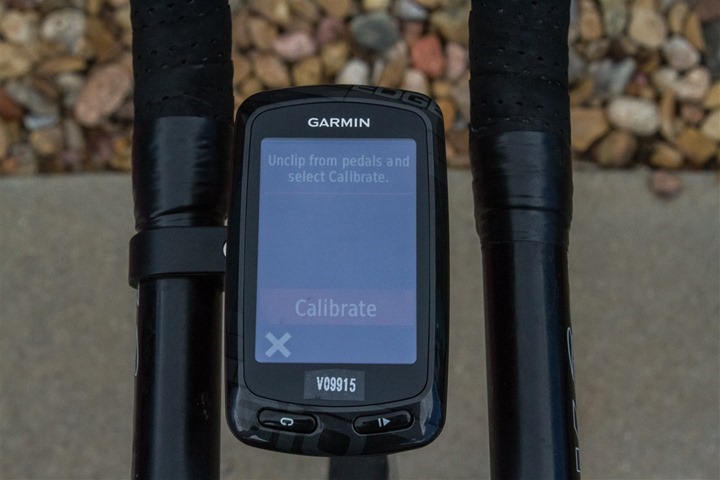
Next is static calibration. This should be done prior to starting every ride, and is fundamentally the basic same process you would be doing on any other power meter on the market. In manual calibration you’ll go ahead and turn the head unit on and navigate into the power meter settings.
Once there, while standing over your bike (or next to it), but NOT clipped in, arrange the pedals in the 3PM/9PM position (horizontal). Technically any position is fine, but the Vector team recommends this position for the highest accuracy.
Next, go ahead and press the calibrate button. It’ll now measure torque on the unit. It’ll come back about 5-10 seconds later and display 0.00, though you may see that value fluctuate slightly as the torque value being displayed is actually in real-time.
With that, you’re unit is correctly calibrated and ready to get on and ride. Note again that this should be done before every ride. Also note that this is compatible with pretty much any power meter head unit on the market (except the Timex units, which don’t support calibration functions).
Dynamic Calibration:
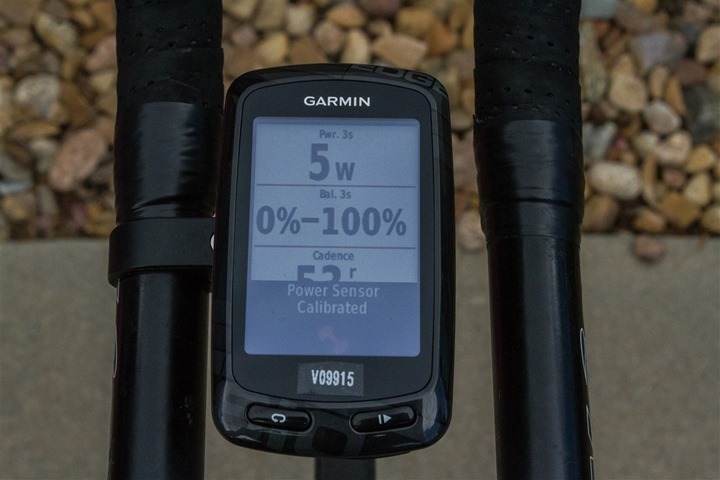
This next calibration type is called ‘dynamic calibration’, because it’s done while the unit is dynamically moving. The goal of this is to remove any ‘clip-out residual strain’ that occurs within the pedal body. This is considered the method to get the absolute highest level of accuracy within the unit. If you don’t do this, you’ll still be within +/-2%, but this gets it a bit closer. And given how silly easy to perform, you might as well.
While on your bike within the first minute of your ride, go ahead and simply pedal backwards. Eight full times. Once done, you’ll receive the message shown above.
Yup, that’s it. As easy as that. You do not need to do this each time you clip out, as they didn’t see any benefit there. Nor at any other point during the ride. Rather, just at the start of the ride. Not that it hurts either.
The Dynamic Calibration prompt message will be seen on the Edge 500/510/800/810 and FR910XT. Other units will not receive a prompt, but the Vector calibration is still done by the pedals. Should other head unit companies wish to, they could add this functionality in, as the confirmation is broadcast in standard ANT+ messages to the head unit.
Static Torque Test (Hanging Weights – for extremely advanced users only):
Finally, we’ve got the most advanced calibration method out there. This isn’t really so much a case of calibration, as it is validation. Within a Static Torque test you hang a weight of a known value (i.e. 25 pounds) on the cranks. In turn, you’re able to get the torque value read back to you, allowing you to validate if the unit is performing within specification. Garmin will be providing instructions and a formula to determine if the unit is within specification. The formula is: Mass (kg) x gravity (m/s2) x crank length (m) = Expected torque value in Nm
To do this, you’ll simply go into the calibration menu, which puts it into a torque display mode:
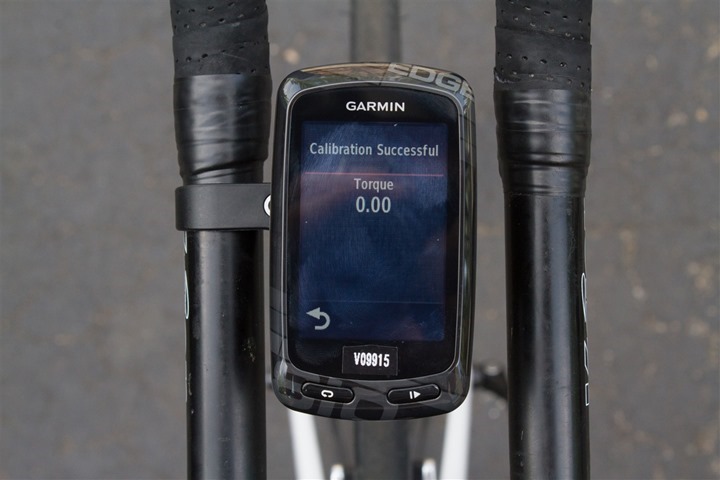
Then, you’ll go forth and hang the weights on the unit. Again, this should be scientific grade weights – not just something random you picked up at Sports Authority sporting goods store. The minimum weight that the Vector team recommends is 25 pounds. You’ll then take the torque value displayed, along with the weights used and compare it against values provided by the Vector team. They’ll be publishing a data sheet in the coming days to the Vector Owners site with the full table of correct torque values for each combination.
What Vector Transmits & Understanding Left/Right Power Measurement:
Vector transmits a number of different metrics to your bike computer. The most basic is simple power, displayed in watts (i.e. 250w).
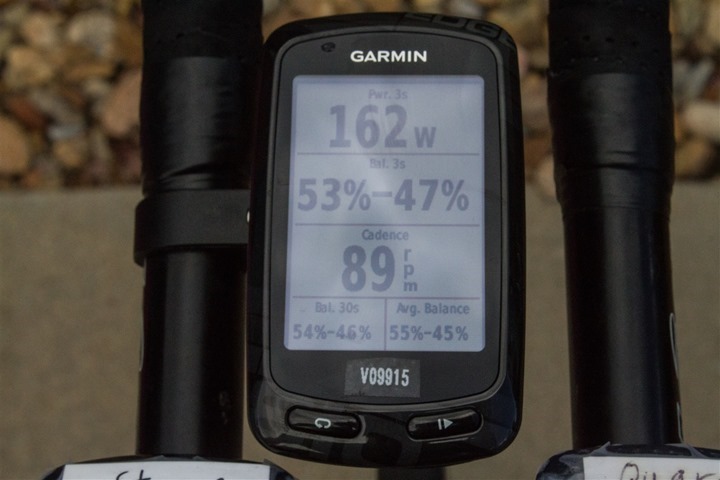
However, the appeal of Vector for some is the ability to get left/right power data – showing exactly how many watts you’re putting out on each leg.
Now, there’s actually not much scientific understanding of what to do with this information yet. While it may seem self-evident to try and work on improving your weaker leg, it’s often been found that in doing so you subconsciously lessen power output on the other stronger leg – ultimately reducing total power (a bad thing).
The one scenario where it’s clear there’s benefit is those recovering from a single-leg injury, allowing them to gauge progress of recovery.
That’s not to say there’s no value in it. Far from it. As it stands today Garmin is working with a dozen academic groups on various projects, all of which are getting Vector sets in the coming weeks. They expect these organizations to eventually publish research papers based on Vector usage. But the focus of these papers (largely) isn’t actually validation of the Vector system or accuracy, but rather related to other research areas. For example, a focus around (bike) fit, fatigue and efficiency.
They know already from their testing that they see “dynamic differences” in pedal balance. For example, different power output levels, different fatigue levels, etc… – all impacting left/right balance. But it’s really going to take a lot of time and data to make sense of it.
And to be really clear, Clark Foy was very upfront that you shouldn’t try and get a perfect 50/50 balance, noting: ‘We’re not saying you should try and go out and pedal 50/50.’ He continued on to clarify that at this point, there needs to be more understanding on how to use the balance information – ideally based on larger sample sets. Sample sets they hope that Vector can help enumerate.
The most useful way to see the left/right data is to add the ‘Balance’ data field. I tend to prefer the 10-second (10s) or longer smoothed variation, as it’s a little easier to see how things are trending.

What’s really interesting here will be to start looking at how this data lines up with both estimated left/right pedal balance (such as that seen on the Power2Max and newer Quarq power meters), as well as how my pedaling balance may or may not impact units such as the left-crank-only Stages Power.
Take for example, this below comparing the same trainer ride with left/right data. Remember that the post-hard torque calibration was done around the 12-minute marker, so really looking at chunks 13:20 till the end.


Speaking of which, it was asked whether or not Garmin has considered just selling a left-only or a right-only system, in an effort to reduce the price of the unit to those looking for less overall accuracy. They simply commented: “That’s a possibility.”- and noted that there’s no technical barrier there. It’s purely a product/business decision.
The two pedals (left and right) that make up Vector work as a primary/secondary system. The right pedal is considered the primary, and the left pedal the secondary. From a data transmission standpoint, the left pedal sends data to the right pedal using a non-ANT+ proprietary high speed multi-node network, which is then transmitted from the right pedal to the head unit using ANT+.
When transmitted from the right pedal to the head unit using ANT+, total power is transmitted alongside of % of power of the right pedal (which allows the head unit to do simple math for the left pedal).
As noted above, the unit transmits power via ANT+, to all ANT+ head units that support the ANT+ Power Meter Device Profile (i.e. any bike computer that supports ANT+ power). However, only head units that have been updated to understand ANT+ Left/Right power will show Left/Right power.
Ultimately, all of this information is later visible on Garmin Connect (the free analysis site from Garmin), as well as a number of other 3rd party applications like Training Peaks and Golden Cheetah. You can see below the left/right balance graph for one of my rides with Vector:

Looking at the above, you’ll notice there isn’t much pedaling on the downhill segments, hence the lack of dots. Here’s the trainer ride as noted above, with shows it across the entire length:

I thought this was interesting to see the calibration point (around 12 minutes) and the slight shift in pedal balance after that point.
Before I get into the next section I want to briefly define two terms: Pedal Smoothness and Torque Effectiveness.
Pedal Smoothness is how even your pedaling is over the course of the stroke. This is similar to Spin Scan as found on a CompuTrainer. Torque Effectiveness speaks to the ratio of positive and negative power – in other words, how much your pulling up versus pushing down. Currently Vector does not transmit this information, however the plan is to add it – though no specific date has been set for that software update. Ahead of that, you’re seeing the various units being updated to prepare for it.
There are four core Garmin bike computer (head unit) firmware updates being added to support various Vector features. Even without these firmware updates you’ll still read most data just fine from Vector. The goal of most of these updates is to ‘streamline’ the Vector experience a bit.
Pedal Smoothness and Torque Effectiveness data fields: This adds these two data fields to the units being updated. These can be added to your data screens. Note that at present Vector does not transmit this information (yet). It’s planned, but a specific date hasn’t been identified. Only the Rotor power meter transmits this information today.
Initial Installation, Wizard for setting Vector Installation Angles: This is the mini-wizard which tells you to spin-up to 80-90RPM and then validates completion. For non-updated units, this will all happen behind the scenes without the confirmation (see calibration section).
Dynamic Calibration Notification: This notification will occur upon backpedaling 8 times, resulting in the display rendering a confirmation message.
Power Meter connection calibration reminder: This is probably the best update of them all, and impacts any power meter. With this update, when the unit powers on and you’ve got a power meter paired, it’ll remind you to do a calibration at that point. Hopefully this will dramatically increase the accuracy of power meter data for the general population that doesn’t do this today.
Here’s the units getting firmware updates, and the schedule for doing so:
Garmin Edge 500: This week, update: now available
Garmin Edge 510: Today, now available
Garmin Edge 800: Today, now available
Garmin Edge 810: Today, now available
Garmin Forerunner 910XT: Within two weeks
Here’s the Vector-related updates coming with each firmware update:
Pedal Smoothness and Torque Effectiveness data fields: Edge 510/810
Initial Installation, Wizard for setting Vector Installation Angles: Edge 510/810
Dynamic Calibration Notification: Edge 500/510/800/810, Forerunner 910XT
Power Meter connection calibration reminder: For the Edge 500 and 910XT, a ‘shortcut’ option to access the power meter calibration is being added (the other units already have it).
Note that some of the updates are also seeing other features/bugs added or addressed. For example, the 810 update sees a number of non-Vector fixes added.
And I also do know that the Edge 800/500/910 updates includes a change to the way the power meter messages are processed for event-based power meters (i.e. basically everything but the PowerTap), which should increase consistency of power meter data recording across the Garmin lineup. The change focuses on not repeating the last power value for 2 entries when you stop pedaling, again, for event-based power meters. PowerTap is time-based, thus it’s not applicable to it. The Edge 510/810 have already been recording power this way previously.
Initial Ride Data Power Measurement Accuracy Backgrounder:
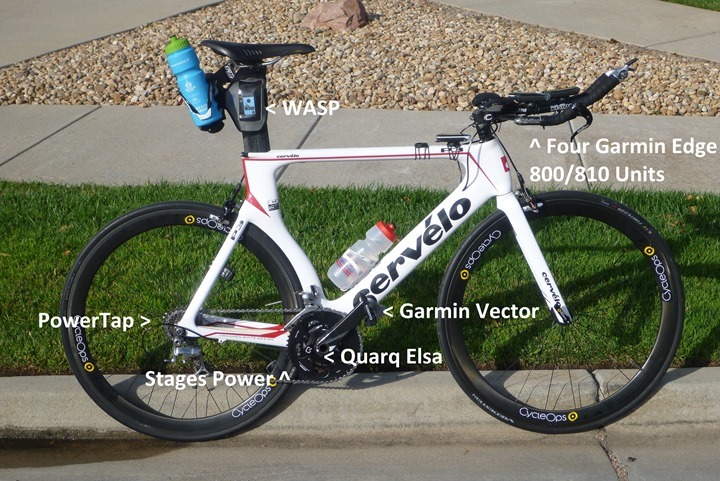
My first question upon hearing of the Vector event was “Can I take my own bike?”. In doing so, I’d be able to get pretty solid data from a battleship of power meters. In some ways, I sorta rolled up to the party a bit overdressed, but that’s alright – I’m used to being ‘overdressed’ when it comes to technology.
Here’s how my bike (the one I own) was outfitted from a measurement standpoint:
– PowerTap G3 Hub (rear wheel power meter)
– SRAM Quarq Elsa (crank spider based power meter)
– Stages Power (left-crank based power meter)
– Garmin Vector (pedal based power meter)
With that, I’m able to track four unique power measurement channels at once. I’m doing that via a small army of recording systems. First is the Northpole WASP system, connected to an iPhone to record the data in real-time from all units. This is the most efficient way I can track data as it’s like listening to everything at once, all the time.
Next, I’ve got a ‘handful’ of Garmin Edge units recording data.
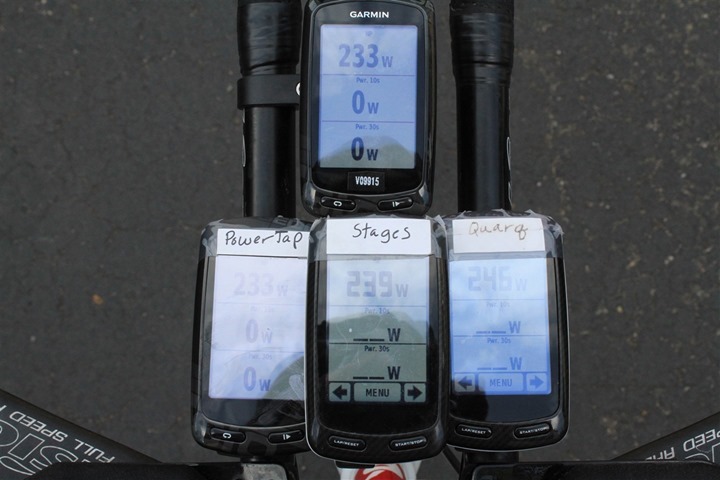
So with that, let’s talk about the tests I’ve been able to complete – all within the last 24 hours.
Group Ride: This was starting from the hotel in Boulder and climbing up Left Hand and into the mountains. This lasted a few hours, about three I believe.
Trainer Ride: This was a short trainer ride I did to get some steady data, see further notes later on.
Solo mountain ride: This was a ride I did later in the afternoon back into the mountains, lasting about an hour, 40 minutes of which was pure climbing.
Over the coming weeks I’ll be able to gather more data – both quantitative (i.e. power meter data), as well as qualitative (non-PM data items such as durability). I’ll publish those all within my full and final in-depth review (again, this post is not a review). In the meantime though, I wanted to get out some initial impressions.
First Rides Impressions:
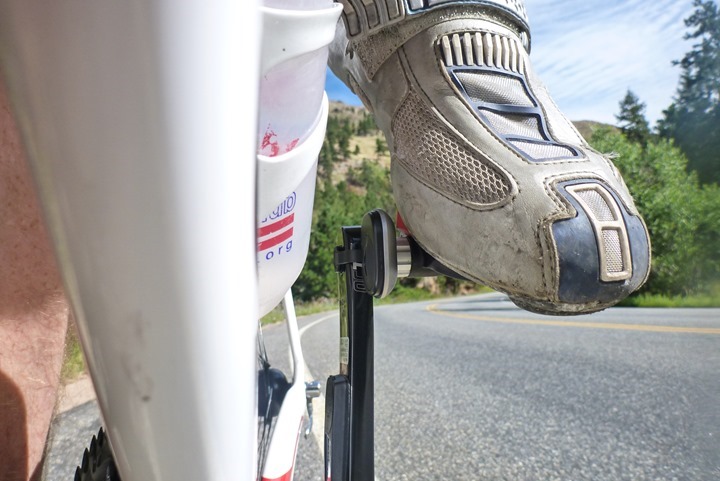
Within the context of those first few rides, my impression of the Vector platform is definitely positive. Outside of installation errors we made (more on that below), the system worked as expected from a functional standpoint. It responds inline with the other power meters from the perspective of how quickly it reacts to changes in power.
When I look at shifting leg power to impact pedal balance, we see that it responds seemingly accordingly. If I apply more force on my right leg, the balance slides to the right. And the inverse for the left leg.
From a cadence standpoint, the unit produced cadence in line with the Quarq (which uses magnets). The Vector system doesn’t use magnets and instead uses accelerometers. There are actually two accelerometers on each pedal. One within the pedal pod used to wake-up the unit. The second is within the spindle and used for cadence, and for setting installation angles. Thus, four accelerometers across both pedals. The system has a cadence range of 30RPM to 150RPM.
Looking at the pedals themselves (and cleats) I didn’t see any issues from a build standpoint. Obviously since they were brand new cleats they clip in a bit firmer than my well worn (as in, worn to almost nothing left) cleats. That’s probably a good thing.
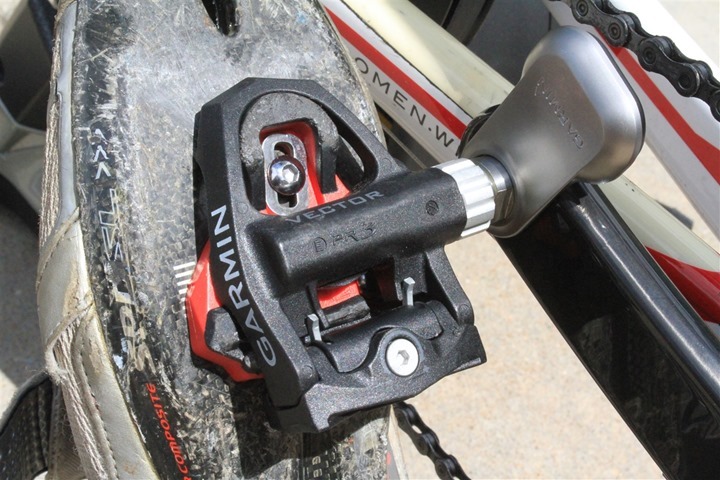
As I saw on my second outdoor ride, the system showed no issues at all in the rain (or accompanying thunderstorms). I simply didn’t see any variations there when I went from dry to wet. Fear not, I’m sure I’ll get plenty more rain experience with them in the coming weeks.
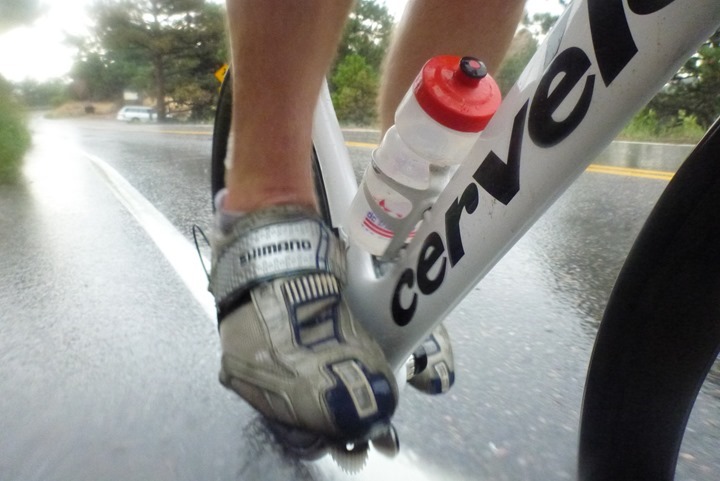
Also, for lack of anywhere to stick battery information – the battery is good for 175 hours of use. The battery level is communicated to your bike computer, with the lowest-battery level being sent:
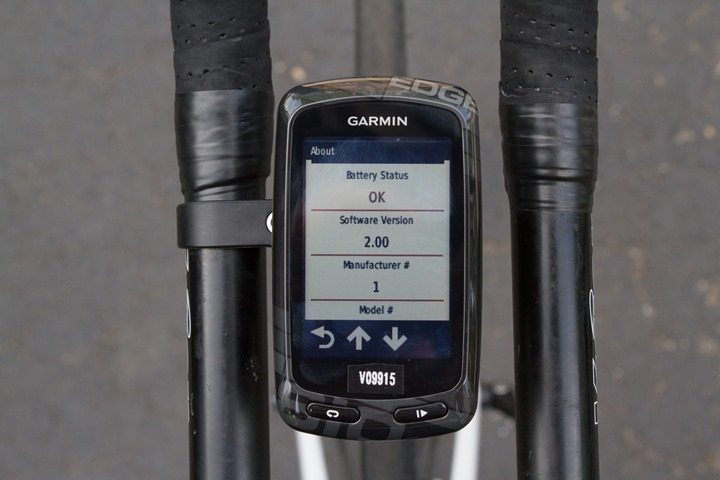
They noted that they tend to see the right-pedal pod burn slightly more battery than the left, simply due to the nature of having to do more work communicating to the head unit. The pods will alert you when you reach 20 hours of battery remaining.
Beyond those areas, I’ve covered much of the remaining quantitative aspects either below in the accuracy section, as well as above in the ‘What it displays’ section.
Accuracy: A look at two and a half rides worth of data:
At almost the exact minute this will publish, on Wednesday morning, it’ll have been 24 hours to the dot that the Vector pedals were installed on my bike. As such, I’m not claiming that this is a complete, or heck – even partial, set of data. It’s just a small window into what will be a large gallery of data in my full in-depth review next month.
But, a window is better than no window. During that 24 hours I went out for a long group ride in the the Boulder mountains. Then after that I spent some time on a trainer. Then after that I went out again for another ride up a mountain. And then, I wanted to just lie in an air conditioned Chipotle for hours. Instead, I wrote this post…for about 8 hours.
Thus, I’ll dive into what data I do have, and make the raw data available to you at the end of this section. Please do take a few seconds to read the background test on each ride.
Ride #1: Group Ride (aka: I learned a lot of valuable things about Vector installation)

As you might expect, I learn a lot about a product during the product review process. Usually that process is over the course of a month or longer. Thus the first few times out with the product I tend to find all the ways not to do something. And, that’d sorta be the case here.
Early that morning while installing the units onto my bike I was taking photos and a team member was doing the wrenching. Because we were taking photos, and because we were ‘on deck’ for a bigger wrench, we didn’t wrench things down terribly tight. In the hustle and bustle of getting everyone ready, we both forgot about it. As a result, my pedals weren’t tight enough…or even close to being tight enough. Which in turn caused the unit to read low (about 16 watts), albeit perfectly consistently low the entire time.
Secondly, as part of that process, we neglected to remember to change the default crank length (172.5mm) to my actual crank lengths (175mm). Which also contributed to things being a few watts low. During the first portion of the ride after I had about 10-15 minutes of data I noticed this discrepancy against the other power meters I was running (total of four). In chatting with the Vector guys while riding we realized the issue with the crank length. So at the next stop before the climb we went ahead and reset everything on the unit (crank length, calibrations, etc…).
Now, with that taken care of, I headed on up into the mountains. And while things looked a bit better, they were still reading a bit low. Again, consistency low. At that point there wasn’t too much more to do other than to just ride-on. So that we did. And here’s what that data looked like:

Upon getting back, we decided to throw the bike on a trainer and see if we could figure out what was up. We decided to start-over with installation. As soon as the pedal wrench touched the pedals, we collectively realized the issue – they were far from being tight. Probably borderline dangerous not tight. So while the comparative data above isn’t terribly useful, that’s alright. The purpose of showing you how to avoid my errors is probably far more valuable at this stage of things.
Ride #2: Trainer Ride (aka: Now we’re getting closer)
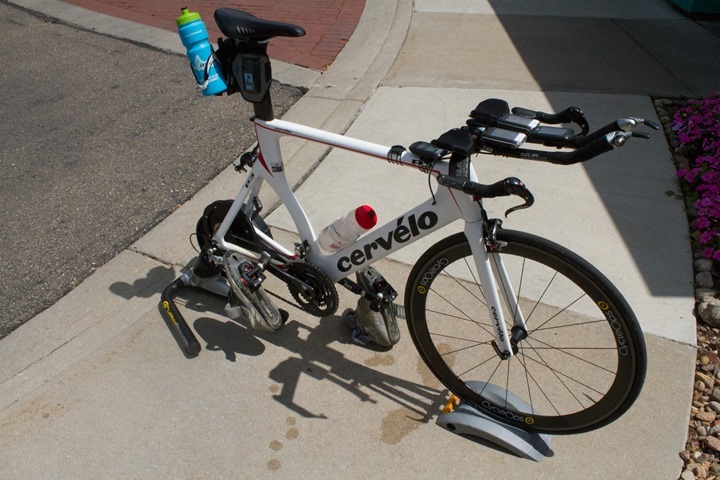
With the pedal tightness taken care of (along with the crank length), we brought the trainer outside. It was a LeMond Revolution (without the PowerPilot head unit), which meant that I lost the PowerTap wheel. Still, three power meters is enough to play the comparison game.
I decided on a simple 20-minute ride (baking in the sun). The first 10 minutes I’d just keep it nice and consistent. Then at the 10-minute marker I’d double-check the calibration on everything. Then I’d go ahead and do a few sprints. The sprints are recommended to ‘settle’ the pedals down a bit after installing the pedals onto a new/different bike. This is the same procedure as found as the Quarq power meters. After that I’d recalibrate and then do some more steady state riding.
Here’s the results of that.

As you can see, things are consistent, but there was still a bit of flex in the data between the different power meters. Not outside of the bounds of normalcy between a given set of PM’s, but some of the shifting between them was interesting. The Quarq appeared to measure the highest, with the Stages and Vector often tracking the closest.
With that out of the way I was starting to feel pretty confident in the installation, and thus, in the data I was seeing. Keeping in mind that the goal isn’t to have three power meters exactly on the same wattage, instead, there will always be some variance. What you want is consistent variance between them.
Ride #3: Up and down mountain ride (aka: I think things are looking good)
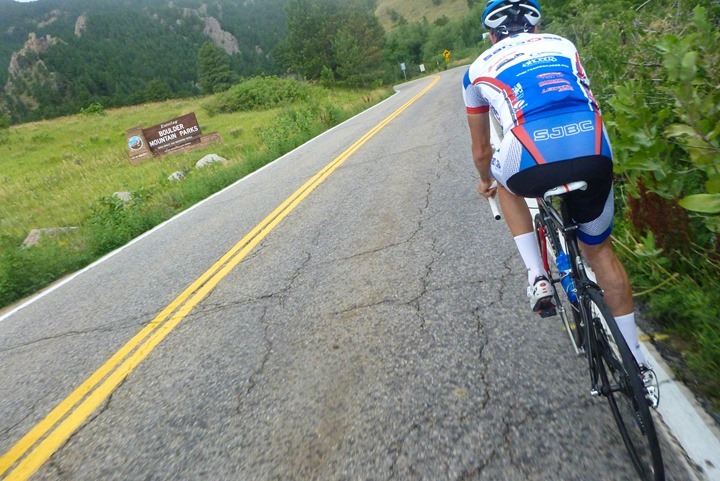
Now 3PM, the day doesn’t seem to end. But I really wanted to get about an hour-long ride in to see how things looked outdoors on the open road with all the changes made.
So Clark and I headed up Flagstaff mountain, a ride that pretty much just involves leaving the hotel and going straight on the same road, and then straight up to the top. I’d climb for about 40 minutes before turning back around. We split up shortly after starting the climb, making it more of a solo climb.
During this ride we did pre-ride calibration per the standard procedures. Then, at about the 5-7 minute marker I also did another calibration on the PowerTap and Quarq. I was seeing the Quarq running a bit high at that time so I wanted to get it back to reality, and suspected the temperature shift coming from indoors might be the cause. Indeed, after doing that second early-ride calibration things were all good again.
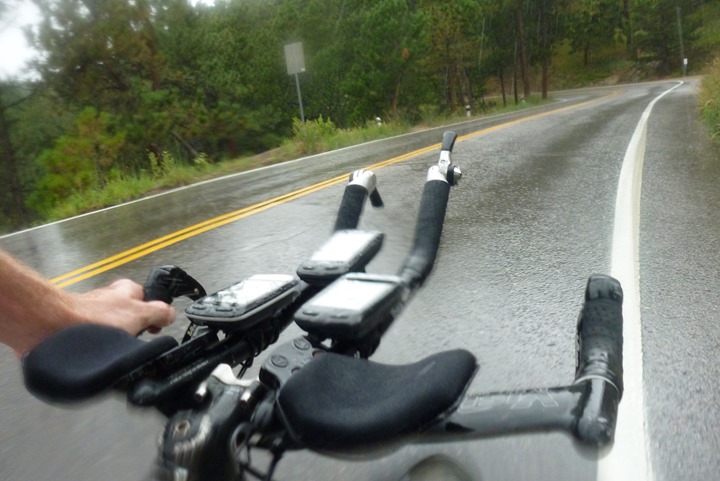
And, looking at the data – it looks very solid. Keep in mind, once you ride non-stop up for 40 minutes, there’s not much pedaling on steep and wet mountain roads coming down. Yes, it rained. And thundered. And lightning.

The challenge with the above is that it’s just too much detail. So I went ahead and did rolling 60-second averages:

As you can see, everyone tracks well – there’s no outliers here. We do see some slight shifts in relationships. It’s those areas that I’m interested in digging into more. For example, typically I’d expect to see the PowerTap the lowest of them all (due to drivetrain placement).
Finally, looking at cadence, you can see things are nearly-spot on perfect. We see tiny variations while descending, likely because I was only moving the pedal one or two strokes in some cases (or half a stroke if banking around a corner), which may be enumerating differently between the power meters. I’m more focused on the first 2/3rds of this chart.

Here’s the four Normalized Power values as well for this ride:
Garmin Vector: 241 watts
SRAM/Quarq Elsa: 241 watts
CycleOps PowerTap G3: 245 Watts
Stages Power: 248 watts
Now, obviously that looks pretty darn good. The Vector and PowerTap are within 1.7% of each other – well within the combined tolerance of 2% each (and that’s before we even talk drivetrain loss). And the Quarq and Vector matched spot-on. All in all, very good.
Over the coming weeks I’ll be collecting tons more data. Assuming the data looks like this last test, then there’s likely little to worry about. Of course, as I’ve previously seen – it’s not just a single ‘good’ ride, but rather repeated rides that show consistency. And don’t assume that the Vector is wrong (or right) in anything above. It could be any power meter. That’s where getting into a more stable testing situations helps, before going back outdoors.
Here’s the data from all three rides, raw .FIT files in a simple ZIP file.
How service/replacement parts works:
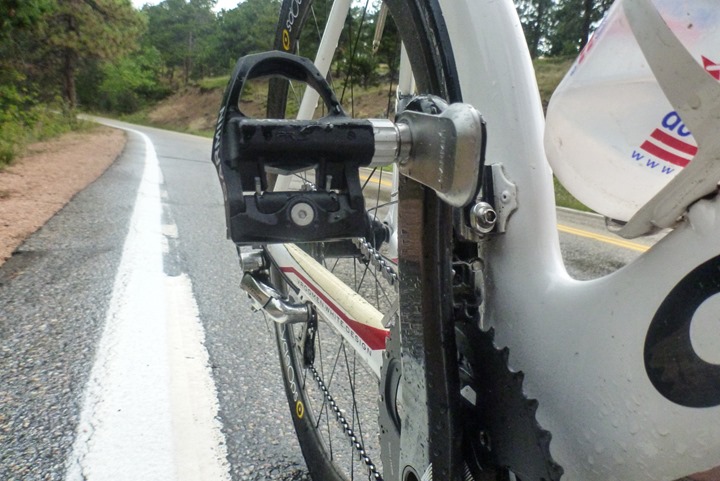
The Vector system has a 2-year warranty, which covers manufacture defects per their standard policy and process. The factory calibration is warranted for 1 year, and Garmin will offer a server to the end user if they are not able to calibrate the Vector themselves (i.e. torque validation).
In the event of an issue with your Vector system (either self-inflicted such a a crash, or unexpected support issue), you’ll start with a call to Garmin support for your local region/country. If they’ve completed troubleshooting and determine there is an issue with the system (for example, the left pedal not responding), then the entire pedal set would be returned to the local country/region support center and swapped out. This process works the same as any other Garmin product.

Now, in the event of the ugly self-inflicted issue, such as breaking a pedal pod on a curb, you can purchase two out of three of the core Vector components.
Parts available as accessories:
1) Pedal Body & Pedal Cartridge Set: $199US = Includes the pedal body, cartridge, as a pair, not including spindle.
2) Pedal Pods: $69US for a single pod (corrected)
The part that is not available as an accessory is the pedal spindle. The spindle is where the magic happens, and where the actual strain gauges are. Basically, that’s the bulk of the cost of a Vector system. Though, it’d be incredibly difficult to damage the spindle even in the most painful of crashes. The spindle is protected first by the pedal body (which Garmin has beefed up over the baseline models). Then you’ve got the pedal cartridge inside that. And finally, the spindle inside the cartridge. Having spent some time toying with the different parts, I’m honestly not sure what type of crash would impact the spindle – short of getting run over by a train. Though, in time, I’m sure someone will find a way.

The two above components will be standard SKU’s that any Garmin distributor/retailer can stock within inventory.
They noted that the part they consider ‘consumable’ is the pedal pods. This is for two reasons. One is that we could see physical changes to the pods, or additional versions of the pods offered. For example, a pod able to accommodate crank arms that are slightly wider than current allowances (they said they’d gauge consumer demand here, but it sounded fairly trivial to offer). They also saw opportunity to bridge into other wireless protocols. Remember this is the communications portion of the device, and today that’s ANT+. But they noted that down the road they could offer a Bluetooth Smart variant, or Bluetooth/ANT+ combo variant. No specific plans or dates are on the table today. But, that would ultimately be a pretty cheap ‘upgrade’ for owners at basically just $70 to get Bluetooth Smart.
Firmware Updating:
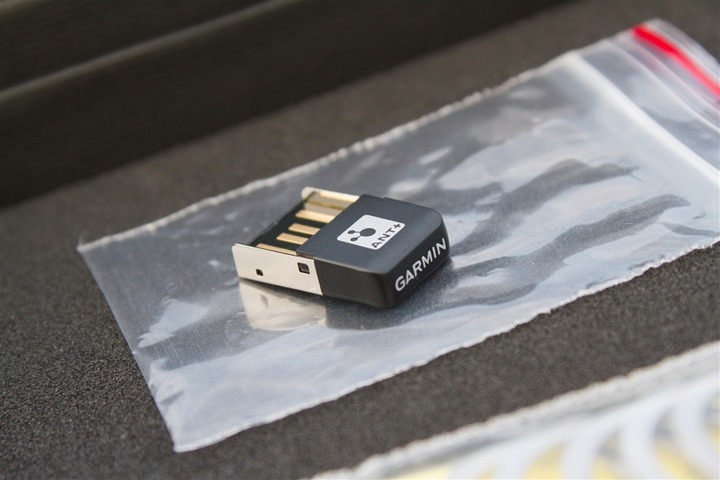
Vector supports firmware updating using the ANT+ USB stick. Firmware updates control the software of the Vector system, and enable it to get new features and updated software. The goal with firmware updates is two pronged. First is to be able to address any issues that may arise down the road. And second is to be able to introduce new functionality down the road. It was made very clear that they plan to utilize this avenue for a long time to introduce features to the platform.
They view the current Vector release as v1.0. Not in the hardware sense, but in the software sense. I asked for example if we would expect to see a new Vector pedal system a year from now, and they stressed anything going forward would be software-focused (outside of new pedal types, i.e. a mountain bike pedal). They have a three year software roadmap of features and functionality they want to add.
But at the same time, they admitted quite openly that there’s a lot of functionality that the greater cycling community will probably want – and they’ve left room on their development schedule to accommodate that. Further, they anticipate that we’re in a bit of a phase of ‘we don’t really know how the full extent of the data can be used’. In other words, there’s a lot of data that the Vector (and to a degree, other pedal-based platforms) can bring. But it’s too soon to be able to really make sense of all that data. The goal of their v2/3/4, etc… plans is to be able to start enumerating that in a more useful metric beyond just wattage and left/right power.
To get started with updating the firmware you’ll need the ANT+ USB stick that came with the unit. That’s the one that looks like the above photo.
From there you’ll need to download the Vector Updater app (PC/Mac) from Garmin.com. Once downloaded, the install only takes a few seconds:

The app communicates with your pedals via ANT+, which is the same technology used between your bike computer and the pedals.

In order to begin the update process you need to put the Vector pedals into a “beacon” mode. To do so you’ll simply pop-off the battery cover on the pedal pods (which pulls out the battery), then, put it back in again. This simply puts the system into the beacon mode. It’ll remain in this mode for five minutes, or until you start pedaling – whichever occurs sooner.

It should go without saying that you do need to have your pedals relatively nearby – within about 10 feet (3m). Then click to begin the search.

It’ll find your pedals pretty quickly, and then enumerate information about them. This includes your current firmware version, as well as the firmware version available on Garmin.com. It should be your goal that these two match. Once the update process completes, you’re good to go.
Remember that post-firmware update you should go ahead and re-do the calibration process noted up above.
Pricing, Availability and Compatibility:
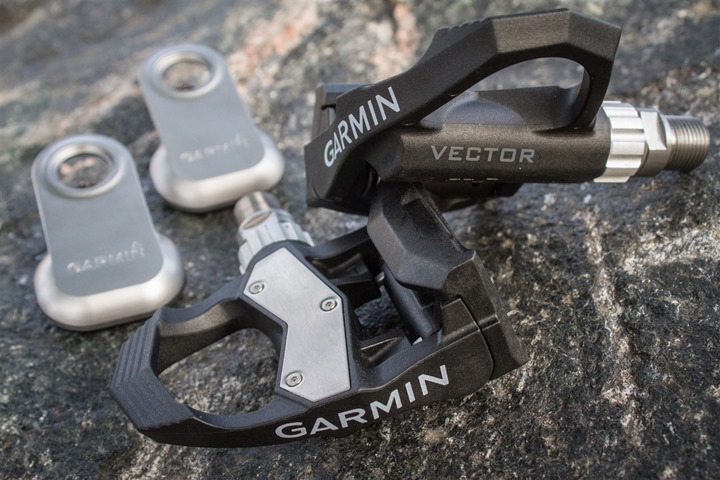
Lastly, the unit is priced at $1,699US, which includes both pedals and transmitter pods (and cleats). The units start shipping today, August 7th, 2013 (yes, that’s this today, Wednesday). For “some time”, Garmin Vector will only be fulfilled through local bike shops, and not through either Garmin.com, nor any other online retailer. In fact, online retailers are not permitted to offer Vector for sale via the Internet (even if they have a physical store). Garmin expects to be able to have distribution flowing to all international bike dealers concurrently with US shipments heading out.
You’ll also need an ANT+ compatible bike computer with power meter support in order to get power information from Vector. As long as your bike computer supports power meters today, then you’ll at least get the most basic information (power). But only newer bike computers made (or updated) in the last year or two support the left/right pedal balance metrics. And further yet, even fewer support the Pedal Smoothness and Torque Effectiveness – though the Vector pedals don’t transmit that information quite yet.
Ultimately, while I’m impressed with the data that I’m seeing after getting everything squared away – I’m actually somewhat more impressed with how much detail and thought appears to have gone into this launch day (Wednesday). When I look at the dozen plus step by step and overview videos, the detailed manuals, and the dedicated tools (apps) to configure Vector, the detail on future plans – it’s really unlike anything I’ve ever seen from the Garmin Fitness division.
As noted above, notwithstanding any issues (with the unit, or my schedule/life), I’m aiming to have a full in-depth review sometime between Eurobike (Aug 28-30th) and Interbike (Sept 18-20th).
Additionally, I’m planning a post in the coming days that helps to make sense of the power meter market at large, talking through each of the options and prices and what my general guidance is. Stay tuned!
With that, thanks for reading! As always, feel free to drop questions below.
–
Update Aug 7th, 2013 9:54PM Eastern: Corrected $69 rate is per pod, not per pair. Added warranty info (2 years), added additional static torque test detail, added detail around calibration prompt for older units, clarified use of accelerometers.
FOUND THIS POST USEFUL? SUPPORT THE SITE!
Hopefully, you found this post useful. The website is really a labor of love, so please consider becoming a DC RAINMAKER Supporter. This gets you an ad-free experience, and access to our (mostly) bi-monthly behind-the-scenes video series of “Shed Talkin’”.
Support DCRainMaker - Shop on Amazon
Otherwise, perhaps consider using the below link if shopping on Amazon. As an Amazon Associate, I earn from qualifying purchases. It doesn’t cost you anything extra, but your purchases help support this website a lot. It could simply be buying toilet paper, or this pizza oven we use and love.























































































Whats “post-hard torque calibration”. Was this a necessary calibration? You don’t mention it earlier until you show the power charts and talk about this calibration happening at around 12 minutes in.
Thanks,
Matt.
Sorry. This is a ‘hard-torque’ sprint. Essentially, whenever you move the pedals between bikes you want to put in about 3-4 hard sprints to ‘set’ everything. Essentially apply hard torque to ensure everything is nice and tight, then go ahead and run through the manual/dynamic calibration process.
That’s what you see mid-way through the trainer ride. We had removed everything and re-installed it pre-trainer, and then during the trainer I did the hard-torque sprints.
Typically just a normal single ride would pretty much do the trick a well.
Will the Vector work with PowerCranks? Ray, thank-you for the informative review.
Henry
I too am very interested to see if Vector will work with PowerCranks. (I have a pair of PowerCranks – very hard to adapt to at the beginning but once you ‘get it’, they have seriously improved my cycling (and running too, for what it is worth).
Its a little tough to tell from the pictures, but based on the relative widths of the average crank arm, the width of PowerCranks, my strong suspicion is that Vector will NOT work with PowerCranks. It will be interesting to see if Ray comes to the same conclusion.
Great review. Thx. Would you know when does Garmin expect to supply Europe (esp. The Netherlands)?
They are currently shipping to Europe. It’s really up to your local bike shop though as to whether or not they pre-ordered and are stocking them. Garmin is not currently permitting companies to resell Vector via the Internet (including LBS’s), so that may make it more difficult to find without picking up the phone.
Ray,
Do you think there will be a noticeable transmission of power from foot to pedal as the cleat wears out. From an engineering perspective, I have no idea if this is a relevant concern. From a cycling perspective, Look compatible cleats have always been one to wear out fast and thus cause either retention issues or a sloppy feeling. Usually due to user abuse but just wondering if this might drift data as things wear out.
It’s funny, that’s actually something we talked about. Right now it’s not a concern, but it’s one of those interesting things that with enough data, you could start to develop trends on the impact of cleat wear.
Thanks Ray, great information, clarity and detail as always!
Any chance you can include a bit of a test on a fixed gear bike in the full review?
At present I don’t have a fixed bike unfortunately. That said, with the easy portability of the units, I’ll keep it in mind as I travel and see what I can do.
So excited for these pedals AND your full review of them! I actually saw them about a month ago as the Garmin rep at an “unknown” 15k road race in July in Utica had a pair of the petals.
You sure it was the real deal? link to dcrainmaker.com
Positive it was the real deal. All the shots that DC Rainmaker has in his post (the pedals, cleats, pod for each petal, the box the petals come in) were exactly the same as what I saw in Utica.
Thanks for your reviews…they are great! +1 on the fixed gear issue. Switching back and forth racing on the road, training on the road and trainer, racing on the velodrome on more than one rear wheel….if this cracks the nut of being able to do both that would be huge. Rainmaker…I can’t even find a note from Garmin on this issue…did *they* do any testing etc? Note that there is a powertap track (fixed gear) hub available (modified through wheelbuilder.com) to compare. But comparing to Stages is also an option.
Brilliant non review Ray. Sure am looking forward to the full review and then hopefully finding stock allows for me to own a pair when I wish.
Tiny point to question, assume any colour cleats are fine and that red come with it but grey are ok to use? (Guess you swapped as you use another cleat type?)
Yup, correct. I just swapped mine out simply because I figured everything would be ‘cleaner’ that way.
But some of the other guys just used what they had on previously.
Any issues getting all those edge units to connect to the power meters? I still can’t get my power tap and 510 to talk
Nope, zero problems there.
Tried the new firmware today, no change. Garmin is shipping me an 810 to replace the 510. Fingers crossed.
Felt like an in-depth review :) phew
Any word from Garmin if they will update the Forerunner 610 to support power readings?
No, there’s nothing planned there.
The real question, especially in light of such closely matching results, is what makes the Garmin Vector worth $1700 vs Stages at $700 or PowerTap at $800-1000. I get having left/right power but in every breath of every review I am seeing that left/right power is not actionable from a training perspective and overall results between all these meters is less than 2% different.
I’m surprised at Garmin, considering their background I hoped they were targeting “power for the masses” but instead went with a high end (right down to the Apple like package) package that may prove in the end to perform no differently that solutions LESS THAN HALF THE PRICE.
Thanks as always Ray, and I look forward to the full review.
I think that Garmin looks at the portability and the platform as a whole as the bigger draws, rather than just left/right data. I don’t think we’ll see that platform fully develop though for a few years – but it sounds like they really view getting the pedals out the door as the ‘first step’ in what is a multi-year software development cycle for data analysis updates.
That said, pricing is something that they noted they’re always watching. Right now it’s really just a supply and demand thing. As I’ll talk about in my upcoming post on the market, the PowerTap move really shakes things a bit – but that will only impact Vector if Quarq matches. But really, at this point, if the Vector units hold from an accuracy standpoint I don’t see any option but for Quarq to lower their prices (at least for 80% of their market, and especially for the Riken units).
Ray, in the future, would you be able to review rotor power v garmin? Thanks for this review.. makes my decision even more difficult..
In the future I hope to review the Rotor units.
As I talked about a little over the weekend, right now the Rotor units are having a number of issues (I’ve heard nothing good from anyone that’s used them – really, nobody), despite being out since January.
Now, I think they’ll get beyond that teething, but it’s taking a long time. Understandably, I can see why Rotor is therefor very hesitant to send a pair over for review. And from my perspective, it’s tough to justify not only spending $2K to buy a pair, but spending $2K to buy a pair to review when I already know there’s numerous issues.
That all said, absolutely, down the road there will be a Rotor PM review.
Yep as Ray says there are very few Rotor units out in the wild now, but they are available to buy if you look. Early problems remain such that it is not up to par at the moment, but hopefully a firmware update due in the next few weeks should fix it. Best advice is to wait a little while to see more reviews on the Vector and see if Rotor’s firmware update works to fix early gremlins.
Any word on what the warranty is going to look like? The std. 1 yr. on their watches doesn’t give me the warm and fuzzies on a $1700 product.
I’ll double-check, I thought it was 2-years, but again, I’ll shoot over a quick note. They did say they planned at least a 5-year lifespan for the spindle, but they just don’t have enough data to know beyond that.
Do you have any idea about the cost I will be facing for the mtb set when I already have the keo set?
No, it wasn’t discussed. But from my perspective, I’d guess the price would be the same. They talked about really have two development tracks for Vector:
Hardward Track
Software Track
The hardware track would be focused on new units for different markets (i.e. mountain bike, spin bike, etc…). While the software track would be applicable to all units across the board.
Knee-jerk reaction to the launch announcement… Go to DCRainmaker. As always, not disappointed. Looking forward to more of your insights.
I agree with Dave C though and will be interested to watch how Garmin fares at this price point.
Thanks!
I was very excited for the Vector when it was announced two or three years ago, but now seeing the goofy pods and the calibration process and the price, NO THANKS, I will stick with my less-than-half-the-price PowerTap.
I agree with some pf the comments above about the price. Hard to justify $1700 for a power meter these days. Disappointing Garmin would come in this high. I am buying my first power meter this year and can’t even consider the Vector due to price.
How about compatibility with the Garmin 705?
It’ll display total power, but not left/right power.
Hey Ray, as far as initial setup, can that be done with the 705 as well. I am thinking more about the step where you need to pedal at 80 cadence to configure the angles?
It doesn’t understand installation angles, however, the unit will simply complete that internally and then once it’s done that will show up as online.
So basically just go ahead and ride down the street (or on a trainer) at 70-90RPM. At some point along the way the power information will start showing up.
Excellent review, thanks for taking the time. The garmin.com/vector website states the compatible garmin models, with the various edge units and the 910xt forerunner. It does not include the 310xt forerunner. Can you confirm that vector is compatible with the 310xt?
Cheers
It is compatible with the FR310XT, it just won’t get full left/right data, only total power.
I’ll be putting together some sort of chart in the next day or two showing all the levels of devices (both Garmin and 3rd party). Just validating some of the data on the 3rd party units.
I’m a bit confused. You say that all power meters require the same pre-ride calibration procedures… but isn’t the Power2max calibration fully automated thus letting the user avoid having to go through that routine?
No, you should still be doing a static calibration (manual) pre-ride with the Power2Max.
In the case of the P2M, it’s equivalent of dynamic calibration is via Auto Zero, which you can’t disable in the current firmware. This does trigger automatically after 2-seconds of stopped pedaling.
Ray is right, just do the so called calibration (its actually a zero offset)before setting off. I like to leave my bike outside for a little while first if I get a chance so that the offset doesn’t drift too much due to temp changes, although the P2M does re-calibrate when it gets a chance.
It will be interesting to see if L/R balance actually has any real value in the future or whether it’s more use as a marketing tool.
Forgot to say, Ray big thanks for the reviews and replies. I can’t wait for the full review.
Thanks I didn’t realise that
Just checked the P2M website under the FAQ section and it says
2. Functioning and quality
How can I calibrate my power2max myself?
power2max power meters automatically update the zero offset when you stop pedaling. Anytime you stop pedaling long enough (approximately 3 seconds or more) power2max updates the zero offset. You can also update the zero offset manually through a compatible head unit.
So the lazy man could turn their head unit on, spin the pedals put water bottles on bike and ride off. Zero offset done….
Is the Vector compatible with the Forerunner 310XT? One one page I found it says it’s compatible with the Edge 500, 510, 800, 810 and FR 910XT. However, another page says only the Edge 500, 705, 800, and FR 310XT support power meters (I assume this page is probably just outdated).
Sorry for posting the same question as a person just above me. I guess I just left this page open for a while before I had the chance to read it. When I left the comment, there were 0 other comments, and now there are over 30.
Great review, especially considering the limited time you had with the product. Looking forward to the detailed (as if this wasn’t detailed enough) review! Completely agree with comments above concerning the price point. $1700=Ouch. I could see paying something close to that IF it came with 3 sets of pedals that could be swapped out (MTB, Speedplay, Look) which would allow someone to use the same spindal across different types of pedals that they own, rent, or borrow (i.e. Speedplay on the TT bike at home, MTB on the spin bike at the gym). I think I’ll be sitting on the sidelines for a while when it comes to this product.
Help! I waited for these pedals so much and now I read that you can not mount on my Specialized SL4 Pro! My cranks are are 16 mm to 39.5 anyone know more?
Alessandro.
The only issue right now is simply the length of the little rubber cable that connects the pods to the pedal spindle. For now they’re just doing the single size of the pod, but they repeatedly noted that if they saw demand for a larger pod size, they’d look at offering it. And when I say ‘pod size’, again, I’m really just referring to that tiny little rubber connector piece that the electrical runs to the pedals over.
The reason you don’t want that piece ‘too long’ is that it would potentially get tangled up on the change if it were flopping around.
Ok thanks for the comment so the extent of my cranks only exceeds 1 mm from the recommended size, I’ll have to hope that someone try to mount them on specy sl4 ….
Alessandro.
Does the rider’s “style” of pedaling matters? If someone uses the cleat to pull the pedal up in order to have some changes in muscle usage when climbing, would the data be accurate?
Thanks
Guilherme
The data would be accurate since it’s still measuring that force, be it being pulled up, or pushed down. I’ll be including a lot more around how things look when you do solo left/right, different styles, etc… I just ran out of hours in the day yesterday before catching an onwards flight late at night.
I think some people might have problems with the chain-crankarm clearance issue, in order to avoid rubbing between the pedal pods and the chain itself when in big chainring/small sprocket combination. They recommend 5mm of clearance and I assume many bikes won’t have all of that. Well, just measured my Cervelo R3 2012 Team Ultegra and it,s around 3,3-3,5mm…
3,88mm EXACTLY
Chain clearance is interesting. On mine for example, it was pretty close, but perfectly within norms. They did a few things on the tiny bit of rubber around the connect in the unlikely event it does come in contact, it won’t catch. They slightly rounded the edges of the cap so it just ‘slides away.
I’ll try and find a way to measure the exact clearance required (travelling at the moment, so finding a ruler isn’t quite as simple as it seems).
My chain line clearance is 2.0 mm on a Trek Madone Dura-Ace 9000 crank… do we have any other new information regarding ‘workable’ tolerances for clearance?… I really would like to go with the Vectors, but my chain line issue may take that option off the table…
2mm simply won’t be enough. In measuring it a bit more (it’s actually really tough to measure, but a trusty Ikea paper tape measure sorta works), the pod sticks out about 1.8-1.9mm. Thus you’d have .1mm of space, which excludes even the slightest of movement in the chain and/or crank arms.
In regard to the Madone chainline spacing, I also have the same setup (Madone 7.9 and FC-9000 crank).
Are you measuring from the end of the crank, or the spindle? The very end of the crank was significantly closer to the chain, but this shouldn’t matter IMHO. It is quite hard to measure accurately but I am getting closer to 4 mm from the spindle to the chain.
I guess I’ll see if it fits this week…
I measured right at the center of the pedal spindle on the crank… I am running 172.5 on a 56 cm frame and gosh darn it, I’m right at 2.0 mm… I’m really bummed…
I better go measure mine again… I’ve got 175 mm on a 58″ frame.
I do think that frame size, crank length will impact the clearance… if only I could ride that 58 cm… perhaps down the road Garmin will tweak that connector on the chain side to allow more systems fit within the specs… so, I’ll probably lean towards the Stages right now… I do have a PowerTap on my old bike, which is now on the trainer, and I just hated being restricted to one set of wheels…
I’m measuring from the spindle – or, at least as close as I can possibly get to it.
I’ll be interested to hear more about swapping between bikes as that’s what most attracts me. How quickly do you think the swap could be done with practice?
I have swapped pedals (not Vector’s) between road bikes in less than 5 minutes with the right tools…
I think 2-4 minutes. Next week I’ll be putting some videos together. I just am travelling right now and won’t have access to a second bike of mine till next week.
When I look at the data comparison between the Stages and Vector and “real world riding situations” i think, “Why in the world would I pay that for a Vector when the Stages would give me good training AND race data (relative to itself) for a fraction of the price?
“ Anyone have practical reasons?
Please see Ray’s pedal balance graphs, I am seeing balance changing over time with couple of %. This is not uncommon.
So with single arm measurement you are having an issue, you might think your power is going up or down, while your effort level stays same. Is it worth double $, well I do not know, that is individual choice.
I am concerned in case bike falls to the side, pedal with hit ground with high impact.
Would be good to test this as part of review, but please do this on cheap bike.-)
Ray, I’m looking for a power meter for my tri bike. I have the Stages power meter installed on my road bike, and it has been useful and reliable over the two months that I’ve had it. I’m intrigued by the Garmin Vector pedals, including the ability to see separate R/L output and ease of transferability. I’m not convinced that having separate R/L information would help me become a better cyclist and I like my current Shimano Dura Ace pedals. Given what you know right now, which of the various power meter would you recommend assuming that I don’t want to pay more than the price of the Garmin Vector pedals? It’s not a fair question given that you have had limited time with the Garmin Vector pedals, but I’m trying to make a decision in the next week or so. Thanks.
I am also planning on making a purchase next week and leaning toward the Quarq Red power meter. My biggest decision right now is should I go with the Elsa in case I end up with a Shimano DI2 groupo on my bike at some point. But should I be thinking about the Vectors? They seem a little clunky/bulky with the pods.
Hey Rainmaker,
Great Review of the Garmin Vector! I think you did an overall great dissection of results of 4x different power meters. One question though, did you ever do a review on the KEO Power? How does that compare among the four above?
I did a review of the Polar-Look Keo Power System here: link to dcrainmaker.com
I did some comparative testing, but didn’t have the equipment I have these days.
I wouldn’t recommend the Polar-Look Keo system as it sits today, for many reasons as I outlined in the review. Primarily due to the head units being so far sub-par for powere data that there should be a new definition of sub-par.
Also, on Polar/Look, no way to check calibration, no way to do mid-ride calibration, no way to get to other ANT+ units, far more expensive, and a solid pain in the butt to install.
That said, a number of those could be addressed with software updates, or a swap of the communications pod (say, to Bluetooth Smat) – which has been planned for some time.
From a lot of experience I can say that the Keo Power pedals are accurate and consistent (within 1% of my SRM). As Ray notes they do need to set up very carefully – much like the vector (everything needs to be torqued up) but also aligned precisely which can take a few installs to get the hang of. Head units are the big problem – they display basic data well but not enough memory or customisation of metrics. Keo Power are going bluetooth, and there will be new bluetooth head units too. Look out at Eurobike….
Hi Rainmaker,
Can Garmin vector pedals measure torque above 150 RPM and below 30 RPM? There are specific types of workouts that involve high torque at low RPM and low torque at high RPM. It would be a problem for me if it cannot measure torque well at those RPMs.
Thank you, Doug.
As noted, it’s beyond the cadence range. I’ll double-check on the power doing an in-person test, but I’m going to suspect it won’t work.
As someone that has been waffling over power for the last year and a half, and now about to have a baby, all roads still point to cheap, hence why I’m still using my 310xt even when I’ve had numerous chances to upgrade. At this point in my life, I don’t see the benefit in buying aggressively new things, but instead piecing my beast together with price conscious options.
As long as I’ve “waited” for vector, I’m kinda disappointed in their price point. For me, my options are now pointing towards Stages or Powertap, primarily because I only do triathlon, no pure cycling. The Powertap might even be a stretch as I already have a dedicated trainer wheel (using TrainerRoad) and a dedicated aerojacketed race wheel.
Who knows, maybe I’ll win the lottery tonight.
Assuming you have compatible cranks, Stages should be perfect for you. Been very satisfied with mine.
What happens if you dip below 30 rpm (can happen when doing uphill force intervals) or go above 150 rpm (I routinely do when doing spin ups)? Does the unit stop registering any power at all or does it represent the power it thinks you are generating at the min or max rpm it allows? And could the rpm range be extended with a software update or is this a hardware issue.
Thanks for your excellent reviews and I look forward to the full-on review soon, especially comparing Stages to Vector.
Great “non”-review. You mention a couple times that Garmin set it up so both pedals are needed. What happens if you use only one pedal? What if you have two pods but one of them is disconnected? Asking on behalf of several people interested in a work around to be able to share the cost…Thanks.
You must have at least the right pedal for it to connect at all to your head unit. If the left pedal becomes disconnected it’ll say “Left Pedal Disconnected”.
You can’t split/share the system, as the pedals themselves are hard-coded. Right is the master, and left is the secondary, all communication flows through the right to the head unit.
Honestly, if you’re looking for something less than half the price, the Stages is the better route at this time. Or, the PowerTap G3 now at $799.
Ray, thanks as always for the great review … even if it’s not technically a “complete” DCR review.
My initial thoughts: I upgraded from an Edge 305 to the 800 a little over a year ago, in the hopes of snagging the Vector PM. Over a year later (and some three years after initially promised), Garmin finally released its product — for $200 more than originally advertised. Meanwhile, I upgraded my entire ride and decided to go with Speedplay pedals. Sorry, Garmin, but $1,700 is really steep, especially with Stages coming in $1,000 less and Powertap now offering wheels for around $900. Also, I’m not quite as impressed as Ray is with “how much detail and thought appears to have gone into this launch day (Wednesday).” Again, Garmin has had literally YEARS to prepare for this product launch; anything less than comprehensive would be very disappointing.
Finally, I’ve recently had another in a series of recurring issues with my Forerunner 610. The quality of engineering and customer service on this device (my fourth in about 18 months), combined with the years-long delays in releasing Vector, would lead me to seriously question the value of switching back to Look-like pedals at Garmin’s premium price. Alas, I wish it were otherwise, as I have only reluctantly become much less of a Garmin fanboy.
Hi Ray,
Are there any plans for the full range of firmware updates to come for all the head units? I have an 800, so I need to upgrade to an 810 for pedal smoothness, or will it come to the 800 eventually?
Great review,
Simon
Hi Simon-
See the section about half-way on which updates are coming to which units. Everything in that section was double-checked with the Vector and Edge/Forerunner teams, so we won’t likely see pedal smoothness backported. Keeping in mind that the Vector units don’t transmit that today.
Great “non-review” Ray. I was waiting for years for the Vector unit to come out and I ended up getting a Stages unit in June. I’ve been very happy with my Stages unit and because I have the same crank on both my primary bikes (Cannondale SISL2) I can swap between bikes very easily (less than 10 minutes), arguably easier than dealing with the Garmin pedals.
It looks like the Vector is a really solid solution. It will be very interesting to see how the market changes over the next 6-12 months with all these new power meters and Powertap dropping their prices significantly.
Assuming stages supports your crank platform, I would find it hard to justify spending 600-1000 more for the Garmin unit depending on the crank. With my current setup of Stages + Look Keo Blade ti pedals the total weight comes to 197 grams with the stages unit only adding 13 grams to the crank arm. The Garmin unit is 352 grams, which is 155 grams heavier. Its not a lot of weight, but its weight in a sensitive area of the bike.
The Stages unit is lighter, less expensive, and allows you to use pedals from any manufacturer. The Garmin Vector is universal and provides left/right balance. If your crank isn’t supported by stages, that’s where the lower price doesn’t really matter if you need to purchase a crank to use their platform.
Hello Ray. Great first hands-on review as usual.
I am using Powercranks. Would the calibration routine work with these cranks?
Thanks.
Funny, I happened to swing by my coaches house this afternoon just after you posted your question. He had an older pair of Powercranks sitting in a box in a closet. So we measured them (since the Powercranks site doesn’t list the measurements).
His were 11mm for the width (width of crank arm), and 32mm for the ‘height’ of the crank arm. In his case, that would actually work (less than 15mm and 38mm). But again, you’ll want to double-check yours.
I strongly suspect PowerCranks won’t work, since the system likely assumes the pedals are pointing 180 degrees apart. I can’t be sure of that, but I wouldn’t buy them until you get an answer to that question.
I don’t see why the Vectors won’t work with PowerCranks. I can’t see where any calculation would require the assumption of a 180° phase difference between cranks.
Not sure about the 180 degrees but I think there is an assumption that both pedals have the same cadence
There’s a bunch of ways cadence could be calculated. For example, assume they calculate it from the time it takes between the pedal pointing down. They might get better accuracy, then, taking the time between when the L pedal and the R pedal point down: that’s a half-pedal-stroke instead of a full pedal-stroke. But if the pedals aren’t opposite each other, this would result in an error. I don’t know what method they use, so this is just a possibility.
Hmm…not sure about them. I love my reliable and realitively calibration free Power2Max and could almost get a second P2M (albeit FSA) if UK prices reflect dollar amounts.
My question is why will none be available to online retailers? Is it because Garmin can’t meet potential demand? This is a definite purchasing show-stopper for me.
I’m hearing conflicting things on why it’s not available to online retailers. It sounds like Garmin is trying to make the local bike shops happy by offering them first dibs on things.
As for the P2M – I do hope you’re still doing a pre-ride calibration.
Yep, I always do the pre-ride Garmin ‘calibration’. Oh well, Garmins loss of sales.
This might seem a little from left field, but input would be appreciated. I’m looking to replace my Timex Global Trainer which died about 4 months ago. I keep casting a eye on the 910XT, and seeing products like this coming from Garmin makes me lean more toward it. What’s the word on getting some of the functionality that the 810 has in a watch like the 910XT? I’m thinking things like pairing to smartphones.
Also, ANT+ only? Do they have any plans for something in BT+?
I don’t think the 910 has a bluetooth chip so I think the phone pairing won’t happen this gen. Next Forerunner I imagine.
I’ve got a power2max and I don’t remember having to calibrate it with steps 6-7 each time. Afaik, it does auto calibration while coasting. Are you sure that EVERY SINGLE power-meter should have calibration stages 6-7 in your list? Btw, it also does measure the left/right power balance. So it seems that the only possible advantage of Garmin Vector is less weight. But how aero is it?
As noted above, for the Power2Max, you should absolutely be doing step 6 pre-each ride. In the case of the P2M, it does an auto zero automatically for you, though you can’t disable that either.
The Power2Max doesn’t do true left/right power, it does estimated left/right power based on the portion of the stroke on a single side. It’ll be interesting over the course of the review to see how those compare. They do seem to trend closely, but the details are still up in the air.
Thanks, Ray.
Imputed gear ratios based on cadence and speed from the four PMs on the solo mountain ride (just the first 10 km or so). Which is the Garmin Vector, the PT, the Quarq, and the Stages? (X-axis is distance in km from start of ride, y-axis is imputed gear ratio based on recorded speed and cadence)
Thanks Robert. Very interesting. I’d be curious which ones were upper left and lower right.
One minor item to note is that the Vector Edge 810 was not paired to the speed sensor like the others, so there may be variance there in that it would have used the GPS distance, whereas the other units will have used the speed-sensor that I usually have (I’ll be setting the speed sensor up going forward). That said, all units were started at exactly the same second.
Boom. OK, I had noticed that the speed signal for the Vector was noisier than the speed signals for the others (the speed data for the Stages and the Quarq, in particular, were eerily close). So, first off, clockwise from the upper left: PT, Quarq, Vector, Stages. Second, it appears the Stages cadence firmware updates worked. Third, it appears this method of calculating imputed gear ratios is pretty sensitive and can help to pinpoint errors in either cadence or speed. Fourth, I sure am glad you’re collecting these data and not me. Thanks!
Solution – Buy the pedals with a friend. Write a Suunto Ambit app to double the power numbers. Now, both of you just need one pedal. It’s Stages in a pedal, half the cost of Vector.
lol why not just get stages. still cheaper I believe.
Except you can’t split the pedals. Only the right-pedal communicates with the head unit, not the left pedal. Left pedal communications go through the right pedal.
It’s Stages, but in a pedal instead of crank arm – that’s why.
DC – I know… but it COULD be possible with some small changes, dropping the price by half. Would be a smart move on their part. If you want both, get the both model. Want single? Get the single model.
Yup, and it’s something they admitted is definitely a possibility. They were clear that’s not a technical boundary, just a business one.
so lets say my cranks are 195mm ? will they work ? i have bikes with 190-195-200 cranks and would love these pedals.
195’s will work just fine. It’s within the 10mm-236.5mm spec.
Add me to the list of readers who are not happy with this ridiculous $1700 price tag. I have been waiting to buy an entry level power meter just because the Garmin vector was on the horizon…what a waste of time.
DC, I will reserve making a purchase until reading your post on the PM market coming out in the next few days, but based on all of your previous posts I am pretty sure I will be going with Stages. Garmin just lost my business.
As I write some of the online retailers in Australia have them priced as low as $1445 AUD. At current exchange rates that is $1310 US. Get googling to find the best prices…
Ray,
Has anyone addressed or made claims about the accuracy of the reported left-right balance? Is it only reported as an integer(s), or is it possible to get a finer resolution, and does that answer differ between real-time display and saved data for post-ride analysis?
Anyhow, leaving the resolution aside, which does limit things somewhat, and presuming that resolution were essentially infinite (perhaps as occurs internally in the unit), there is still the question of how accurately the balance is determined, even if the overall reported power is within 2%. I’m not sure whether the 2% is supposed to be an absolute worst-case or some type of statistical (to some probability level) guarantee. Potentially, each individual pedal’s power might be known less accurately than 2%, while still achieving 2% overall power accuracy, and there is also the question of what degree of statistical dependence or independence there is in the power determined for left pedal vs. the power determined for the right pedal. When thinking about calibration, power balance adds another subltlety for consideration – so perhaps both the calibration procedure and random within-ride (dynamic) variations affect the accuracy of the reported power balance.
If you don;t know the answer, perhaps you could pass this on to Garmin for their feedback. Thanks.
It’s reported as a percentage, which is basically just doing simple math on the total wattage. In fact, if you look at the ANT+ spec it transmits total power, and then %Right power. So apps beyond that could get more detail as far as exact watts if the ywanted.
The 2% is supposed to be worse case of the full system (at least, that’s how every other company normally defines it).
Of course, validating the power balance is virtually impossible today with the tools I have available. What I can validate is torque on a pedal and the like, but doing a dynamic validation of those values isn’t possible (since I don’t have a robot that swings weights around the pedals).
Ray,
Whether or not you personally are able to validate it, it seems to me that Garmin should make some (hopefully valid) statement about the accuracy of the reported power balance.
There are definitely differences and quirks which occur. I’ve run a keo power system with a rotor power crank and they produce different L/R balances but very similar total wattage. Which is absolutely right? I don’t know, and there is a lot of variation that goes on from pedal stoke to pedal stroke. Both of these systems may deal with negative torque differently. the Rotor power samples at 500 hertz which is industry leading, but there is a lot of averaging going on in the power meter itself (several seconds at least). There is a long way to go to determine the utility of all these metrics. I for one cannot absorb or do much during a ride with total power, balance, torque effectiveness and pedal smoothness simultaneously displayed. Post ride analysis is where most use will be. Power balance has been useful for me in recovering from injury.
It would be interesting to see sprint power too, for us roadies you know :-) How about 5s, 10s, 15s, 30s, 45s, 60s intervals? Just doing some sprints and then checking for the peaks with the Golden Cheetah “find intervals” feature to see what comes up would be useful, just to see how the Vector deals with sprinting compared to Quarq and PowerTap.
Thanks!
Thanks Ray, nice work.
It will be interesting to see how sensitive the calibration is to the torque of the pedal installation. You mentioned having a pedal or pedals not quite tight and that resulted in an error in power measurement which looks to be roughly 5-8%. Does installation require a (good) torque wrench to validate how tight the pedals are fitted?
I am a little confused as to why the back pedal 8 times would be required to improve accuracy. I’d have thought that being unclipped is the only time the meter(s) is(are) assured of knowing precisely what forces are applied to the pedals (i.e. none).
Cheers, Alex
It doesn’t require a good torque wrench, just using a simple pedal wrench like normal is sufficient. In the morning business we had just used that tiny little wrench you see in the photo and didn’t tighten it thinking we were going to tighten it later- rather than using a proper pedal wrench.
I’m getting a more detailed explanation on the unclipping tension release and will report back.
It’s a good point Alex. The accuracy (and consistency) of Keo Power is also very dependent on precise installation (both lockring toque and alignment). Personally If the Vector is affected as much as Ray states then I’d be using a torque wrench otherwise you could not be assured that the data is accurate and consistent (particularly when transferring from bike to bike). I think the dynamic calibration (zero offset) is interesting too. I suspect the reason is that when clipped in the additional spring tension on the pedal body would exert a small force on the spindle that would otherwise lead to a small over reporting of power…. One of the quirks of measuring power right at the transmission interface?
Thanks Ray.
Hopefully someone will check the impact of pedal tightness on measurement.
Yeah, that pedal backwards 8 times thing to be *more* accurate is weird. That and the ~150rpm limit means it’s use for track racers may not be ideal. I mean 150rpm+ is hardly unusual for a track racer.
Ok, now I’m getting a better grasp on this. It’s so expensive because it’s TWO power meters. Garmin is trying to market it with all this extra software analysis of smoothness and left-right and other jazz. Stages has proved that you really only need one side. Somebody needs to make a single-pedal power meter and also offer a dual-pedal combo that just does this extra stuff if you have money to blow and want that extra upgrade.
Stages haven’t proven you only need one side. Such a solution might provide sufficient precision for *some* applications, but not for all.
Noticed a couple of comments about fixed gear bikes and comments about Specialized cranks. I have been interested in this system since the Metrigear press releases. I got tired of waiting for the pedals and at the beginning of this year I invested in a PowerTap G3 wheelset for my training bike and an SRM crank for my race bike (so that I wasn’t limited to a single wheelset for racing). However, I still don’t have power (for racing) on my TT bike or on my track bike (for training and racing). These pedals seem like a cost-effective solution for sharing a power meter between both of those bikes.
I’ll have to wait until I get home to measure the S-Work Carbon Crank Arms on the Shiv but what others have reported isn’t promising.
My question about using the pedals on a track bike is related to the calibration step that requires you to pedal backwards for eight revolutions. How would you accomplish that on a fixed gear bike?
Thanks for your detailed report on the Vector system and for all of your consistent, balanced product reviews.
I’m getting some more clarification on the track/fixed bike scenario, specifically due to the backwards pedaling piece. They’ve said that technically the unit would be within spec without it, but it wouldn’t be as accurate.
Regarding track bikes, the Vector team confirmed there’s no practical method today to get the dynamic calibration done with Vector (on bikes that don’t permit backwards pedaling).
what ive done to do the backwards pedalling calibration on my fixed gear bikes is drop my chain,hang onto something solid, pedal backwards, put chain back on, ride.
Awesome review. Thank you so much.
For the triathletes that must leave their bikes in transition over night and cannot take the bikes out of transition in the morning, how would one calibrate the pedals so that the pedals immediately start working and transmitting power information when you transition from swim to bike?
Thanks again!!
The pedals immediately wake-up upon movement (rotation). I’d do a static calibration in the morning, and then go ahead and at some point in the first mile or two do the dynamic calibration (backwards pedaling). That’s what I do with other power meters today.
Wouldn’t temp change be enough to cause the morning calibration to be off? Then again I’m not sure what the difference is between the two calibations (the internals of what its doing, not the easy to understand difference in doing them)
No, because the unit is pre-calibrated for specific temperatures at the factory, done on each individual unit prior to factory departure. Remember that these are silicon strain gauges and not foil, so the temperature fluctuations are well established.
Ray,
Do you know if one can swap pedal bodies/cartridges on the spindles? I am running a tandem where the stoker is facing backwards so I swap pedal bodies on spindles for that rider. The bike is a land speed record human powered vehicle streamliner. Thanks!
Thanks for the write up.
Probably been mentioned already, but only operates unto 150 cadence???
So basically, anyone who actually cycles will find this limiting.
Strava etc guestimations of average power over a longer are often fairly good.
Peak values for sprints etc are often over 150 rpm. Last night my ride hit 190 rpm. I usually try hit ~200.
Ok, ok, for most cyclists this won’t ever be an issue. Then again, most cyclists don’t have a power meter, and don’t plan on buying one. Let alone an expensive one.
As for mountain bikers. I wouldn’t touch these with a 10′ pole.
My flat pedals can lose up to 10 replaceable pins from a single ride, bashing them on rocks, logs etc.
SPD’s have a lower profile, and are amazingly tough, but still cop a pounding.
I’ve been e-mailing with the Vector team about the cadence items today. They’ve noted that the 150 is more of a soft-limit, and specifically in certain edge cases. They’re going to go ahead and send over a detailed explanation of those edge cases.
Yes, the 150 RPM upper limit isn’t great… my son hits 170 RPM almost every time in the final sprint of his weekly crit.
Hi All-
Just a quick heads up on some adds/changes:
Update Aug 7th, 2013 9:54PM Eastern: Corrected $69 rate is per pod, not per pair. Added warranty info (2 years), added additional static torque test detail, added detail around calibration prompt for older units, clarified use of accelerometers.
“Note that steps 6 & 7 should be done every ride. This last component is no different than any other power meter on the market today.”
Simply not true. Bias is showing through already.
In that statement I was mostly referring to step 6. But I’ll correct that to clarify just step 6. I’d be interested in which power meter you wouldn’t do that for? Stages is actually the only one that’d be considered option – they say about every few weeks, but it doesn’t hurt to do it.
Btw, I’d be curious what bias it is that I’d be showing that says you should calibrate your power meter?
Powertap, quarq, stages don’t require a two step calibration for every ride.
Odd, it seems pretty clear to me.
Quarq: Page 13 of their manual, specifying to calibrate before every ride, and then during a ride if temperature changes or if the user feels the values are out of line.
PowerTap: Troubleshooting section of their new site, specifying to static before every ride, and then during the ride enable auto-zero, which simply does exactly what Vector is doing with the offset. They recommend enabling that function.
Stages: See their FAQ page, under calibration, specifying to do so before every ride for best results. As noted above, they are the exception in that they don’t have a secondary offset procedure.
So yes, I absolutely have a bias for getting accurate power information from the devices I use.
I really wish Garmin would stop using the term “calibration” when they really mean “set the torque zero”.
Calibration means validating the power meter’s accuracy. Garmin’s “calibration” does no such thing.
Setting the torque zero is necessary but insufficient step for validating a power meter’s calibration / accuracy.
Checking/setting the torque zero should be done before every ride and occasionally during a ride, no matter what power meter you use.
rfuller better get some aloe on that burn
I hope the companies that you review realize how many purchases I/we have based on your reviews. also I would like to point out that split left/right readings are very helpful when dealing with injuries. You can see the immediate affects of an injury on your power splits, and you can then work to even them out with rehab. I
Not sure I really agree on the left-right thing with injury rehab. It’s more of a curiosity than anything particularly useful. But if it helps with motivation to get back some fitness, it’s a good thing.
US$ 1,700? What happens with the 1400 dollars advertised? I’ll wait for more 3 years for the less expensive unilateral vector
Do you have a feel for where Garmin is with supply and distribution? In other words, when will there be sufficient available for me to walk into a LBS in a major US city and walk out with them. Also, what is your prediction on Internet availability — e.g. Number of months?
I think you’ll start seeing them arrive by Friday, which is in line with what I’m hearing from various shops. Then wider availability next week. If you can’t get them the week after in a local shop, it’s likely (though not 100%) because the shop placed no pre-orders.
For internet, that’s really tough, hearing lots of conflicting things. At the event, they said “some time”. I get the feeling that may be mid-late fall. Obviously, giants like Wiggle and Amazon aren’t going to be thrilled with missing out on sales for terribly long, so I think it’ll probably be short lived. Heck, even Garmin.com is really in that same boat – as a result, Garmin themselves would be missing out on significant profits not having to pay retailers/distributors (figure 30-40%). I get the feeling this is more of a ‘feel-good’ play than anything else, as it’s something that wasn’t communicated prior to really just the last week or so.
Looking at supply and distribution, they have additional flexibility to add one more line (if I remember correctly I think they have three lines running today). Lines have been running for two weeks now, and in fact, the batch we all received came from that first week of production.
Currently the number I’ve heard mentioned is fairly impressive for unit production. All Vector shipments are being air-shipped to Olathe. The process takes two days from departure out of Taiwan assembly (post-testing) to arrival into Olathe for distribution right back out again. All North American shipments go via Olathe. Other regions are occurring concurrently through the various regional hubs.
Rey,
From this photo here link to dcrainmaker.com
I was like WOW with both eyes opened as wide as they can go. I think you have more electronic on the bike there, i find it hard to see a bicycle!
thanks for the first review. I see that you must have had your hands and feet on the vector a while back before everyone else.
again very well tested, well done!
thanks,
champ
Thanks Champ.
Nope, I got the Vector pair at the same time as everyone else this time. Obviously, like others I’ve been talking with the Vector team for over 2 years now, so that helps in understanding the platform pretty well.
Looking forward to the full review.
Not sure if I missed this in your update and responses, but some questions.
1) If I already have a separate Garmin Cadence/Speed sensor, what happens regards the built in accelerometers in the Vector pedals and the cadence data from them?
2) Is there an analysis data/software tool to show instantaneous power at any given angle of the crank arm….ie to see what power you are applying at any given part of a pedal stroke?
Additionally
2.1) Can you compare Left/Right leg power in relation to crank angle and power being applied
2.2) Is there any impact for people who have elliptical front chain rings
3) Interested in Speedplay and Shimano pedal options are planned
I can comment somewhat. On 1: I’m not sure which the head unit will use, but Vector cadence should be good, and since it’s better sync’ed with power (coming from the same sensor pack) it would be better to use the Vector cadence, I think. 2. Clark has announced that pedal analysis is for the future. Force-versus-angle would require a high data transmission rate, much higher than the present Vector uses. 2.2: It depends on how cadence is calculated internally. If they measure the time taken for the pedal to rotate 180 or 360 degrees, the accuracy issue with elliptical chainrings remain, because the error comes from the assumption of constant chain speed. If they measure cadence “instantaneously” ellipticals won’t be an issue, but there’s challenges there. SRM & Quarq, for example, have the same issue. Powertap obviously does not, since it cares only about the “cadence” of the rear hub.
2.2
The use of elliptical chain rings will have no impact on the power values being calculated by Vector as it is computing the power generated at the pedal interface and that is where it is also measuring cadence.
The use of elliptical chain rings will impact how that power that is input at the pedal is delivered to the rear wheel.
I should have added that it performing multiple cadence calcuations per revolution.
Thanks Dan,
I sort of guessed they will need to increase the sample rate to get force/angle data.
I was hoping to hear that there would be a “pedalling action test mode” the unit could be switched to, enabling this higher rate sampling to get the force/angle data.
The obvious trade off would be battery and memory consumption, however this would would be to do a deep dive and analysing pedalling action rather than analysing/feedback of a ride.
Again, I would see this “mode” to be more off a standalone pedalling action test you would run to look at pedalling efficiency, rather than recording power output for a ride or monitoring instantaneous power output within a ride. ie how to efficiently improve power output thru improved technique rather than just increasing brute strength to increase power output
Ray
Thanks for the short review (non review). Do you know if those actually work with the knee savers (little barrels pushing the pedals further out)?
Dave
These won’t work with them due to the need to plug in the rubber bit.
But, You could use a longer axled BB axle (Square/Octalink/Isis) or if you are insistent on Hollowtech a DA 7803 crankset has a longer axle but the triple inner connects to the middle ring (not the spider) so it can be used as a “wide” double.
I’ve always used speedplay pedals. the appeal in the vector is the ability to change from bike to bike. My hesitation is changing pedal system. what is your experience regarding look/exustar pedals like with regards durability and float.
Thanks
“Speaking of which, it was asked whether or not Garmin has considered just selling a left-only or a right-only system, in an effort to reduce the price of the unit to those looking for less overall accuracy. They simply commented: “That’s a possibility.”- and noted that there’s no technical barrier there. It’s purely a product/business decision.”
They will do. First they wish to sell some for those who are not so price sensitive not to lose this extra profit. Keep in mind that in spite of nagging people there are lots of people being pleased with the brandname Garmin. From them there are enough people to buy a PM of 1700 USD in the next months.
In 6-12 months Garmin will come back with a price of let’s say 60% for a one leg solution. For those who has less money to spend on a PM, but has some desire for a PM.
I am quite sure that it is their policy.
And that’s what I would buy. I’ve been using power for almost a decade; long enough to know all this left-right stuff is a red-herring only for those easily distracted types. As long as you’re able to compare different times during the same ride and different rides to each other accurately, that’s all you need.
I agree the left-right thing is a red herring when you are measuring both sides, however the elements of using power data you describe may well be all that *you* need but they do not reflect the needs of everyone.
Some of us use power data in many other useful and creative ways for helping attain performance improvement, and hence we evaluate each product through the lens of what the meter (or headunit) is and is not suitable for.
Some applications for the data are far more demanding than others, and some meters are not suitable for those more demanding applications.
Hi Ray.
Just wondering if you have heard anything regarding the Brim Brothers power meter. This seems to me like the other player in the market that will be able to offer easy bike to bike transfer and possibly left / right data. They are not very good at keeping their website up to date so just wondering if you new more?
Thanks
Matt
Nothing recently on Brim Brothers. But I suspect I’ll chat with them at Eurobike in a couple of weeks and get a better idea of where things stand.
Thanks Ray,
How are the existing speed and cadence sensors to be used given the vector measures cadence (ie: can I still use my garmin speed sensor?)
Cheers,
MDM
Elephant in the room……
Garmin’s manufacturing problems with all their other units. Any inkling on whether they’ve sorted out their issues?
For better (not or worse), virtually everything Vector was done by the Vector team (California), or teams out of the Alberta offices (Dynastream). Very little involvement from the traditional fitness teams. Time will tell of course if there’s any hidden issues, but everything I’m seeing shows a more solidified package that I typically see from other groups.
The vast majority of issues people have with Garmin units aren’t the hardware itself, but rather the software. There are no doubt some minor bumps in the road we’ve seen on the hardware side, but they’ve always been corrected and folks offered free swapouts, even long-after warranty expired (see: FR610 band/backing issues, where you can still get it swapped out today from Day 1 units).
No Speedplay pedal no deal. I have the look feel and functionality of their pedals. Deal breaker.
Same with me, but then because of SPD-SL.
For those asking questions on what the Garmin head unit does when it has multiple sources for speed/cadence information here is the order it will use the sources in
Cadence
Cadence from power meter (except PowerTap hub)
External Cadence sensor
Cadence from PowerTap hub
Speed
Speed from PowerTap
Speed from external sensor
Speed from GPS data
Thanks Alan! Always useful.
Is this the same for 910xt? as when I was riding my bike last week, I got a bit of a hinky gps signal and when I checked the data I was riding like 60 KM/h). I would have thought the data of my gsc10 would keep the 910 in line.
Maybe split the cost with a friend so each person gets one pedal? ;)
As noted, today, Vector requires the right pedal to be operational. All data transits the right pedal on the way to the head unit.
Aw shucks. Missed that part.
What pouch is that on the seat post?
It’s just a simple Wahoo Fitness iPhone running arm band. It holds on perfectly there, and I can get it very secure. It’s a great place for the WASP because it’s virtually unobstructed to all the lower ANT+ sensors (crank/wheel/etc..). I’ve tried in my back pocket, but my body blocks the signal and I see occasional drops (not good for PM comparisons).
Thanks for the review Ray,
What I was wondering, since the strain gauges are on the spindle, is will it measure higher power if you pedal more with the outside of your foot (as some people tend to do out of the saddle – particularly those that ‘throw’ the bike around) than your normal pedaling action.
This would increase the leverage (and presumably the measured strain) on the spindle without applying additional force – unless i’m missing something…
Maybe you could test for this?
Hmm, perhaps Alan is able to elaborate more. But, keep in mind there’s 8 strain gauges on each pedal, spread across it, thus they’ve got pretty good coverage there. Also note that they’ve talked about being able to use it for fit related items, specifically distribution of force on the pedal itself.
Hi Ray, thanks for the nice review!
Just a question, do you think the pedals will pair with the o-synce navi2coach? And will i get the same detail of informations like with the Garmin 810/510
It should work just fine per the spec, but I’m going to give it a shot today though.
That would be really nice to get some infos! I’ll go to the eurobike so i hope i will see the pedals live!
Hi Ray,
Did you had a chance to test the navi2coach with the vectors?
I used it with the Navi2Coach the other day, and it seemed to record fine, but I need to poke around at the TrainingLab software a bit more, as I’m not seeing it showing the Left/Right stats there. Likely something wrong I’m doing, so I reached out to the Navi2Coach engineers to double-check.
Note that Navi2Coach has already added the Pedal Smoothness and Torque Effectiveness.
could a person split the pedals if they bought a regular set up 2 bike w power.
As noted, today, Vector requires the right pedal to be operational. All data transits the right pedal on the way to the head unit.
The 150rpm cadence limit and the requirement to pedal backwards means that the Vector is completely useless for track cyclists.
I touched bases with the Vector team and got more detail on the cadence maximums, here’s what they had to say: “Our design is limited by centripetal acceleration at the spindle, and the conservative limit that we have stated (which we expect to satisfy all bike setups in all road conditions) is 150 rpm on 200mm cranks. If a cyclist is on shorter cranks (e.g., 172.5mm), the limit goes up beyond 160 rpm. On track conditions or smooth road surfaces, the limit goes beyond 190 rpm.”
gives there some problems in use with the edge 500 at the calibration?
thanks for info …
It works with the Edge 500, and in fact, the Edge 500 got a firmware release yesterday specifically to simplify calibration pieces for Vector.
Hi Ray,
I remember on a previous firmware update some people were complaining of their 500 head units freezing up and doing strange things. Have you heard of any issues with the lastest firmware update?
Great report. Do you think you could experiment with differing left and right crank arm lengths? That might help in answering the differences between left and right power output readings.
Vector only accepts one crankarm length in its configuration (this is partially governed by the way the ANT+ bike power profile is set up). I’m not sure what using different crank lengths on each side would prove?
In a limiting case, you can unclip on one side and pedal with the other. It will show 100% on the side you’re pedaling with.
The “limiting case” wouldn’t be helpful. Too bad the Vector only accepts one crankarm length.
It seems like most reviews are using the Garmin 510/810. Has anybody tried with the 910xt? How would the multisport mode of the 910xt affect the calibration of the Vectors?
Any plans to make a longer Pod attachment to accommodate cranks with >38mm height(width) like the Rotor Flow? It seems that is going to be issue for Garmin boys as I have noticed that most of the riders are using Rotor Flow cranks on both their road and TT bikes
Yup, I detailed out some of their plans above for potentially offering a wider pod. In fact, the Flow was specifically mentioned during a presentation.
Nicely done as always. After reading the pre-review, and then the other reader comments … all my questions (noted while reading the pre-review) have been answered.
One note for feedback to Garmin. I, as with several other readers, have heartburn regarding the price. At this time, I will be going with another meter (have been holding out for awhile), but will keep my eye on the progress (and price) for a future alternative should it be needed..
Again, nicely done on the review.
I bought the Vector pedals yesterday (8/8) and installed them today (8/9). I discovered, however, that my Edge 810 has firmware version 2.6 and the Garmin Dashboard indicates that my firmware is up to date (though the support page says version 2.7 is available).
Long story sort, I finally called Garmin Support and they said that they are having problems with the Dashboard page. Currently in order to update to 2.7 you must download Garmin Web Updater and update the 810 though the application. Here’s where to find it:
link to www8.garmin.com
Yup, I’d generally recommend using the Webupdater over the dashboard. It just ‘always works’. For those keeping track at home, updates are now out for the Edge 500, 510, 800, 810. The FR910XT is still a week or two away.
Again note that you don’t “need” these updates to use Vector, or even configure it. These updates just simplify configuration and provide a bit of a wizard.
Thanks for the first looks, Ray!
If I purchase the Garmin Vector now, do you think in the future I’ll be able to swap to mountain bike pedals by simply swapping the cartridge and pedal body, rather than needing to buy the whole thing again?
I don’t know on that one. I know much of the spindle design will remain the same, but whether or not it would be perfectly interchangeable seems like something that could be impacted down the line. I’ll check though.
Hi Gennaro-
Regarding being able to swap spindles down the line (i.e. road to a mountain bike pedal), here’s what they had to say:
“No, it would likely be a different spindle. The force path through a road pedal is different than the force path through a MTB pedal, and would require a slightly modified sensor system.”
For those interested, here’s another set of data from all four power meters from a 2hr long ride I did on Thursday (solo). This was on Skyline Drive just outside of Washington DC. Ride contained sun, mountains, significant temp swings and rain.
While I haven’t had a chance to look at the data in detail, looking at the Garmin Connect files as well as during the ride – things appeared to track very well between them all. Here’s the Garmin Connect links for those just wanting to browse:
Garmin Vector: link to connect.garmin.com
PowerTap G3: link to connect.garmin.com
Stages: link to connect.garmin.com
Quarq Elsa: link to connect.garmin.com
And then here’s all the full/raw data files (with ride notes and WASP data): link to sites.google.com (Corrected link)
Note that I’ve included the WASP data, be aware that the WASP data records at a higher data rate and averages all the sub-1s times in, so you’ll see slight differences between WASP and Edge data due to that.
Enjoy!
Ray,
What happened with the elevation data in the Stages file? It is way off near the end where you were descending from Dickey Ridge Visitor Center to the park entrance gate and back up to Dickey Ridge, and has bogus elevation statistics as a consequence.
Yeah, it looks like a few of the units had trouble with elevation on this ride. Typically when I see that it can often be linked to water somehow getting stuck in the little barometric sensor holes on the back of the Edge units (four tiny little pin-hole sized dots). That sorta pans out only because it was raining for quite a while.
Hi Ray,
Your raw data link points to the Stages review from Jan 29… I found the Vector ride data anyway.
Eek, sorry, wrong link indeed. I’ve corrected the above link, and here’s the correct ZIP file for those following along via e-mail notifications: link to sites.google.com
Thanks — the Quarq data look absolutely excellent here. A quick scan shows excellent agreement between Vector and 103% of the Powertap (adding 3% as an estimate of drivetrain loss). Quarq curiously falls slightly less than Vector. It would be tempting, but not responsible, to assume this is power loss between the pedal and spider, although I’d expect that power loss to be negligible. Left leg power from Vector matches Stages/2 better than right leg power, which is of course expected (comparing total power with stages is silly, since nobody claims Stages measures total power).
Between James Huang’s data, your initial ride data, and the data of the commenter it appears Vector is susceptible to low readings if not carefully installed. It will be interesting to see if these other users are able to bring their agreement up to the really excellent level your units have reached.
Looking fwd for:
– avg 3″,10″, 30″ Power Zone and %FTP
Any new implementation in the next fw release?
I haven’t heard anything about those metrics being added.
Was able to get my hands on Vector on thursday but they seem to record low data. Using 1 washer on a set of Vision Trimax TT cranks (165mm, properly configured using the desktop utility). Used them in an olympic distance race today and averaged only 200W for a >22mph bike split with plenty of rolling hills and especially wind, I weigh 200lbs. Any ideas?
A couple of quick thoughts:
1) With 1 washer, is it (the pod) flush against the crankarm, or popped out a bit?
2) Since you’re using the desktop utility, I assume it’s not an updated Garmin unit. Did you walk through each of the core calibration/setup steps then on the site:
A) A few quick/hard sprints to ‘set’ everything (first time)
B) Installation Angles (basically just pedaling)
C) Then manual calibration
D) Dynamic calibration (backwards pedaling)?
When you did manual calibration, what was the torque value returned?
What head unit or watch were you using and what cranklength was it set to?
The bike profile settings on a Garmin watch or Edge will overwrite whatever settings Vector might have. This is done on purpose, because otherwise switching bike to bike (where the cranklength might be different) would be onerous.
Thanks for the quick reply! I guess its all in the washers…
1) Added a second washer and went on a long ride today. Nothing anywhere near the race effort from yesterday and averaged the same wattage… so it seems to have done the trick. It was not flush with 1 washer though. It looked like the image in your review.
2) I was using the desktop utility as my headunit is a garmin 910xt.
Manual calibrations return a 0 for me.
Any word on the crank length setting coming to a garmin 910xt near you? Or a iOS setup utility… at least that way the garmin ant+ dongle may have some use!
Hi Marko, was interested to see that you’ve got Vector on vision Tri Max TT cranks. I’ve got these on my bike but had assumed that they were too ‘high’ to accommodate vector. Are your cranks the same wide carbon ones that I’ve got? and if so was it a struggle getting vector to fit them.I notice my cranks are asymmetrical so have a bigger distance between the pedal and the front of the crank than between the pedal and the back of the crank.
Matthew,
Mine are the low end Alloy BB30 kind that comes stock on the Felt DA4.
link to visiontechusa.com
They fit without any drama since when each crank arm is facing forward the thinner part of it is below the pedal screw hole. This is the part the vector pod has to straddle with its wire and there is plenty of clearance (~2mm) and no strain.
However I am not sure if the carbon crank version is the same dimensions…
Marko
Thanks for this Marko, looks like my cranks are slightly higher but if there’s 2mm of space on yours they might still fit mine.
Ray, do you know of anyone who’s managed to get them on the vision tri max carbon cranks?
Thanks again.
Thanks for another great review.
A quick question.
I see that the ANT stick in the pictures is a small suunto like one and not the old big one. Do you know if that is what Garmin now will provide also with the 910XT?
Steen
Yes, new FR910XT units are now shipping with the new mini-stick. You can also buy it solo too.
This site is really top notch. I don’t think I’ve ever seen such full and well put together reviews. Thanks!
I do have a question, or maybe something that could be added to the comparison report you are working on.
I am fairly new to riding and have never worked with power before and I want to get a PM. I am torn between Stages, Quarq (Elsa/Riken) or Vector. All three seem to give consistent results, but the aspect which worries me the most is drift. Assuming I manually zero before a ride, I might not know when I am getting drift during a ride and when to zero again. Therefor drift could really affect my results.
Which is the worst offender and, given my concerns, which should I avoid?
From a drift standpoint, it appears the Stages drifts the least – but also has the obvious technical limitations of being left-leg only (whether or not you feel that’s an issue varies on purpose). Vector doesn’t appear to yet have any drift issues (likely due to the items I’ve outlined above around temp compensation).
Quarq doesn’t inherently have temp compensation, though you can (and they recommend you do), occasionally pedal backwards to compensate it.
Great first review – thanks! A few questions:
– Did Garmin give any indication on when the pedals will start transmitting torque effectiveness and pedal smoothness?
– Any idea whether a BB86 frame with Shimano 9000 cranks (52/36) will have enough clearance for the pedals?
– What’s the sampling frequency of the pedals?
I’m building a new bike, and I’m between these and the Rotor Power. I think I’d rather get these, but really want to get the extra data fields (and be sure that they’ll fit before ordering the crank!).
NB. I spoke to Rotor the other day and they say that they data problems they were having were fixed by several firmware updates – on the Rotor itself and on the Garmin head units which were apparently struggling with the amount of data being transmitted.
Thanks!
Thanks.
1) No clear indication on date. But clear indication it would be included. Many of us pressed for a date, but didn’t get one. I suspect sooner rather than later, if I had to guess.
2) I don’t have information on specific cranks unfortunately. Garmin doesn’t plan to publish a full spec-list of compatible cranks (though, I think that’d actually be a good idea). Of course, crank-compat is only one issue, the second is clearance of chain (which they said wasn’t something they saw issues with).
3) 1-second is the current recording rate of the ANT+ units. Though I’m seeing transmission rates from pedal to head unit at .25s (normal for most PM’s).
4) As for the ROTOR units, I kinda put it in the camp with any other unit I test “I’ll believe it when I see it.”. I’m hoping they sort it out, as I think competition is great. And I’ve heard from a few others about this mythical up and coming firmware update. But, at the same time, I also heard the same before each previous update.
Cheers!
Thanks – awesome quick response!
2) I was concerned about the BB86 part, but thinking about it that’s probably irrelevant right? I’m going to go out on a limb and assume that the Dura Ace 9000 would be one setup that they’d ensure would work. :)
3) I was trying to compare the Garmin against Rotor’s published “500 times a second” figure. Is it all moot, given that the head unit only records once a second or 4 times a second (0.25)?
4) Yeah, I’m inclined to think the same way.
Thanks!
2) Oh, yeah, on the BB part, that’s totally irrelevant. Same impact as your bell or light choice. ;)
3) Yup indeed, the 500 times a second is a useless number, since all ANT+ head units on the market today (for consumers that you can buy) all record at 1s. Down the road there’s talk of a few companies up’ing the recording rate to allow for various high-speed analytics, but I’m not seeing that happen immediately.
Are any power meters using any average schemes before transmission?
they all do
The SRM track power meter and head unit allows samples to be captured at 0.5 second resolution.
It’s one of the major selling points for track riders.
Wow!
For a preview review you have covered a lot of ground and instilled a lot of interest.
As usual, the best, I mean best, reviews.
Thanks Ray.
Did Garmin mention anything relating to this pic at all?
link to bikeradar.com
It would suggest that the strain gauges are spaced around the pedal spindle, e.g. at 12, 3, 6, and 9 o’clock, and that the pedal would be able (in the future) to look at each reading independently. I’m envisaging a really cool feature – theoretically the system could analyse the angle of force being applied by the rider at all stages of the pedal rotation and compare it to the tangent line at each point. Could be a good analysis to improve efficiency of a rider’s pedal stroke…?
The metrigear folks showed some demo footage which plotted the force vectors acting on the pedal (this was before metrigear got bought by Garmin).
If you need this level of detail, it is available on static ergs like the Wattbike.
They talked to the capabilities of this a bit. We’ll see some of this with the new pedal efficiency and torque effectiveness capabilities, but some will be on a longer roadmap.
I’m wondering how to know when the pedals are correctly torqued? Any torque wrench I have seen is a socked style not an open wrench style. How do you know when you are at the correct torque?
Great review!
Crow’s foot adapter. Local hardware store should have these.
They had a torque wrench which worked quite well the 2nd time around. Here’s a pic I took of it: link to sites.google.com
I’ll try and get the exact model number for those interested.
Just an FYI for those receiving e-mail subscriptions (or reading through comments). The below are two posts that a reader did that are well worthwhile reading (they dive into my data):
link to djconnel.blogspot.com
link to djconnel.blogspot.com
It looks like a standard torque wrench it’s what’s on the end I would like to see. So it is a crows foot adapter, that makes sense, if you could get a link to that I would appreciate it. Thx.
Here’s a bit more detail from the Vector guys on the exact torque wrench and adapter they are using:
“We use a Craftsmen beam style torque wrench (3/8” drive): link to craftsman.com
…with a Proto 15mm crowfoot: link to grainger.com
The 15mm wrench or crowfoot must be thin enough to fit on the wrench flat of the pedal spindle (1/4” or less).”
My only concern is that the pedal units are based on the old HM-style Looks. My last two pairs started creaking badly after a few 1000 miles. Have you experienced this at all, Ray, and am I right in my assumption that the Vectors are indeed based on this model and are a regression in this regard when compare to the new “blade” Look’s?
Another exceptional review, thanks! With the new pedal based PM, should we start a collection to buy you a new pair of cycling shoes? :)
Nah, nothing another round through the washing machine can’t fix…
Can understand people disappointed with the increase in price but not the general criticism of said price.
Still a fraction of SRM cost and far more practical for anyone swapping bikes. I wouldn’t want my future bike purchases driven by BB or crank compatibility.
Also, is $500 more than Stages in Oz. say $200 for pedals and $20 for cleats.. less than $300 difference. ($950 for stages in AUD delivered, $1450 for Garmin)
Must be difficult for the other Power sensor mfgs now when the owner of ANT+ is entering the business at a low price point.
ANT+ power meter units with lower price points:
Stages ($699)
PowerTap ($799)
Power2Max (~$900-$1000)
Quarq Riken ($1499)
ANT+ units with higher price points:
SRM
Quarq Elsa/RED
The other power sensor mfgs must be upset by Garnin entering the market. The end of ANT+?
No, definitely not from this. Keep in mind that shipment of ANT+ components in power meters likely doesn’t even hit a tenth of a single percent compared to ANT+ in heart rate straps, GPS watches, footpods, etc… All of which are areas that Garmin has long competed with other companies that use ANT+ (Timex, CycleOps, etc…).
Hi, tks very much for the review.
Cani use the Vector whith a campy super record Eps crank ?
And Look Keo blade pedals ? TKS
You’d have to check the measurements of the crank arm against the specifications noted above to be sure.
Just measured and only have 4mm between crank and chaiin big/small combo.
SRAM Red cranks on a 2012 P2.
Reading lots of people with the same issue and wondering how universal these are actually going to be?
Wouldn’t it make sense to design something that fits comfortably rather than on the borderline of workability.
Or have I got it wrong? 5mm minimum? Any workarounds?
So I just did some quick measurements of my bike.
Right now, my clearance is about 3-4mm (slightly hard to tell in that the rule I found has about a 1mm gap off the end).
At that point (the in smallest ring/gear in back and biggest in front) the Vector pod connector still had at least 2mm until it touches. The pod connector sticks out 1mm, perhaps 1.5mm at most.
In short, I think their 5mm is a bit overcautious.
Awesome, thanks Ray. Figured there would be a “margin” in the recommendations, just didn’t want to pull the trigger only to be unusable when they arrived.
Hi Ray, what is the Garmin mount you are using on the aero bars?
It’s the Barfly TT: link to dcrainmaker.com
That’s ace, thanks Ray. Have you ever used the Garmin Out-Front mount? If so, can it be rotated and mounted aero bars? The Garmin website doesn’t provide much information at all!
I’ve tried it, but I found that on my aerobars it’s too big and is like using a pair of handcuffs on a baby.
Another great (pre) review Ray…
Any chance you could put a power meter poll on your website for those about to make a purchase?
Perhaps people can then put their reasons in the comments… For me i think stages is going to be the big winner – mainly from value for money despite being left only. I’m also not a massive fan of the vector design of the pedal pod – i think a better design would have internalised the pods rather than having them stick out waiting for an accident to happen (whether that be while riding or even putting your bike in the car/garage and having them get bumped). Maybe that will come in the next version along with a price drop to compete…
Personally, I’m excited about the vector. I like the idea that I can easily switch this between my older bad weather bike, new road bike, and TT bike. There really is not a better solution for someone wanting to train and race on multiple bikes, all with different BBs.
Stages isn’t the cheapest option for everyone. Say you bought a Fuji bike that comes stock with Opel cranks. That means you can’t use a Stages pm without replacing the whole crank which takes the price above a powertap wheel. (And might need a new bottom bracket too)
Would it be possible to fit a different pedal body onto the Garmin spindle/axle? Something like a look keo blade or the new aero model that’s coming out. I’m guessing there’d be a nice weight saving in it…
hey,
is there any possibility to swop the electronical stuff from the vector pedals to look keo aero pedals?
should be possible, or not?
Hi DC rainmaker, I have a Garmin vector paired with my Garmin Edge 510. Great pre-review. I have a question, how do you get pedal smoothness to work on the Vector. I added it as a metric to the edge but nothing is registering with data. Power, speed, etc works but not that.
Pedal Smoothness isn’t implemented in the current firmware on the pedals. It was added to the head units, but the only power meter out today on the market that supports it is the Rotor PM. Garmin has said they will add it to Vector, but declined to specify a timeline.
Ray, is the Exustar pedal a standard model in their line-up or is it made specifically for the Vector? I want to do some research on it as a pedal but I’m not sure what to look for. Also, does Exustar have any plans to offer a lighter platform for the Vector? Something like the Keo Blade would be really nice.
The pedal body is a version of the that has been modified to fit the Vector spindle. I don’t think anyone has given any insight into plans for different pedal platforms.
It’s specifically made for Garmin, to different specifications that they’ve driven. They talked to us about the fact that they re-enforced the pedal body greater than the standard spec.
well…got a problem with mine…
One of the 4 pins on one of the pod is not coming out and so not touching the pedal…
“left pedal not found”. I’m about 99.9% sure this is the issue since I exchanged the battery between the 2 pedals and I’m still having the same issue (the right pedal is detected in both cases).
If I push the 3 other pins they come out again, but not that fourth one…
Will go see my LBS tomorrow :(
Just back from my LBS…they are supposed to receive 3 pairs tomorrow. will get one of those.
According to Garmin: link to support.garmin.com{74cdf8f0-f5a9-11e2-7dd9-000000000000}&locale=en_US
the pod needs to be replaced…Wow. Why not have 2 points of contact (8 pins) for each of the 4 “rings” on the pedal to minimize this kind of issue…?
Hopefully my LBS has a set left and will be able to replace it. :(
Oh well…got reimbursed…my LBS can’t get another pair for another month! Will buy a new one next season :(
Out of curiosity, why didn’t you call Garmin support instead? They’ve got a system in place to swap them out.
Called them with my LBS an they told them to return them to their provider. Provider would get a replacement (was told very quick), but then they called this morning and told me it would be a month…
Looks like they have a hard time having spare.
Hi mate,
I understand that you got more accurate readings after tightening the pedals to the required torque. What brand / style of torque wrench did you use for setting the torque value before use? The installation of the Vector shows an open-ended wrench is required. However, torque wrenches typically sold for bicycle use (with a dial to set n-m) do not contain an open-ended spanner nor tighten beyond 15-20 n-m.
Thanks
Nik
Yup, here’s the exact details of what was used to get mine put in place correctly:
====
“We use a Craftsmen beam style torque wrench (3/8” drive): link to craftsman.com
…with a Proto 15mm crowfoot: link to grainger.com
The 15mm wrench or crowfoot must be thin enough to fit on the wrench flat of the pedal spindle (1/4” or less).”
===
I’ve ordered a few different crowfoot adapters off of Amazon as well to see if there are other ones that I can confirm that fit. I found that if you go to Sears (popular in the US), you can find the wrench pretty easily at most places. The exact Crowfoot adapter above is also on Amazon: link to amazon.com
I just got my Vector pedals. At first I tried to hand tighten them with my Park pedal wrench and got varying results. I’ve since then ordered the torque wrench that DCR recommended and in the process of looking for the crowfoot wrench that is thin enough to fit the Vectors (since the ones that DCR links to do not ship the Canada!). I noticed that the .25 inch thickness recommended doesn’t actually match the description of the product itself – it states 0.4 inches – so now wondering if it can be 0.4 instead of 0.25? Seems harder to find crowfoot wrenches that thin.
Thanks Alan.
Yup, I ordered a bunch of adapters off of Amazon and am going to get some more detail on what fits (and doesn’t). It all arrives tomorrow here in France, so won’t be able to get more info till then. I’ll also try and find some local ones here in Europe at the hardware store to help out folks on this side of the pond as well.
How did the crow-feet comparison go? Any recommendations? Also, do you know the recommended torque setting (e.g. number of inch/lbs or foot/lbs)?
I haven’t taken everything off yet to do the differing force tests, I’m going to do a shoot of all the install pieces later today.
At any rate, 25 foot-pounds is the recommended force. And what I’ve used and gotten really good results with.
I did confirm (as expected) that the Proto linked crowfoot DOES work just fine: link to amazon.com
However, I can also confirm that this specific one DOES NOT work (too thick): link to amazon.com
I also went to three different hardware stores here in Paris, along with three hardware stores in Canada – none of which had them. One hardware store in the US did, but only if I bought a set of them for $50 or so. I did get the torque wrench easily at Sears however.
The more I see peoples results, I’m starting to come to the opinion as others, that Garmin should definitely be including this (the adapter) part in the install kit. I don’t think they should include a Torque wrench, since realistically every other power meter requires it for install (PowerTap excluded).
But given Garmin’s manufacturing capabilities, creating one of these (adapter) would be silly-trivial (in cost and design) and make a big difference in installation accuracy. Having now been to Olathe and seen the division that creates prototypes for parts, this would be so straight forward it’s laughable. And for accuracy, one only need to read Wattage-forum and other posts to see this continues to be an install fail-point.
Hopefully they’ll look at announcing including such a part before my review next week…
they definitely need to include one…as you said here in Canada I can’t walk into a store and find one…Had to order and will only get it in about 4 weeks.
Two questions.
1. I live in a very hot place! how will this impact the accuracy of the garmin vector? What about when you ride in place where the temp changes radically like in the mountains where it can be near 0 C at the top and 40 C at the bottom?
2. I really like my speed play pedals and I have to say I’m quite disappointed that they went with a look based system. It sounds like they are unlikely to change platforms but did you get any indication that they may open this up?
Thanks for the great non-review on this and every product!!
1) Temperature has no impact on the unit, it’s pre-calibrated across a wide range of temperatures (those specified in the manual).
2) They do plan to go into other pedal types, but plan to focus on other cycling types first (i.e. mountain), before diving into other road pedal types.
Hi DC!
I want to get some of those pedals in the next few weeks.
In general, I’m a “pure” cyclist but do also some runs for regeneration and as an alternative to it. So I don’t know if i should use an 510/810 AND a watch for running, or quite using an 910xt. Are there any modes/options the FR isn’t able to do in comparison the de EDGE? (display values, calibration, etc.) What would you prefer?
Thanks for your answer!
With sporty regards from Austria (not Australia)
Chris
The FR910XT won’t get some of the automated calibration parameters (though, you don’t really need them), further, it won’t get Pedal Smoothness and Torque Effectiveness (once those are added to Vector).
If you’re a pure cyclist, I’d go for the Edge 510/810. If you run two or more times a week and want GPS on those runs, then I’d go the FR910XT. Or, you could always pickup the Garmin quick release kit for $10 and run with the Edge units (albeit bulky and without ‘pace’ metrics).
For those interested, I’ve just uploaded a pile of raw data from a longer trainer ride this evening. The data includes 5 different head units connected to 5 power meter sources:
Garmin Vector
Quarq Elsa
PowerTap G3
Stages Power
CompuTrainer
Additionally, it includes WASP data. I haven’t dove into the data yet, but I figured many here might be interested. I also included some 60s left-only and right-only pedaling for fun towards the end. Rides notes within zip file.
link to sites.google.com
If you happen to do some analysis of the data – feel free to link to it here (just click ‘reply’ on this comment). Enjoy!
Hi DC,
Another great review/”non-review”. I am an avid reader of your reviews and order from your links whenever possible.
As I have used Speedplay pedals/cleats on all my bikes up to now, I have a rather naive question about the Look Keo cleats as I am expecting a pair of Vectors in the near future. Are these cleats unique to the Vector pedals? I see that there are replacement cleats on the Garmin website (red & black), but there seem to be other “Look Keo” cleats available. For example, ” Look Keo Grip Replacement Cleats” in Grey (4-5 degrees), Red (8-10 degrees), and Black (0 degrees) and “Look Bi-Material Replacement Cleats” and “Look KeO Grip Road Cleats” and probably other names and cleats that I missed.
Could you please tell me which, if any, other than the cleats that come with the Vectors are compatible.
Thank you for your answer.
Looking forward to the “full review”.
Best,
Howard
From my position these look like the only real solution. I cant use and crank based PM on any of my bikes as I have both different BB types and more importantly different crank lengths (for very good reasons). having a power-tap would limit me to 1 wheel for all bikes which is also not an option…. So this is why ppl have been waiting for a working peddle base power meter.
I also see that you listed that for about $200 you could get a replacement Pedal Body & Pedal Cartridge Set. Ideally when a MTB version comes out you would only need to purchase the MTB Pedal Body & Pedal Cartridge Set and then use the same spindle and pods and you have the one powere meter that works for all your bikes…. the $1700 (or even $1900) doesn’t look as expensive when you start putting it on 3 or even 4 bikes. My GF could use the same peddles and it is multiplied even more (although not when we ride together obviously that’s up to 6 bikes with no 2 combinations of crank length and BB repeated). 3 x stages is now more expensive, if you can even get them….. which you can’t outside of North America as they wont ship them internationally at this stage (pun intended:).
As it is I have one set of road peddles now that I change at least once every day in about 2 mins and this looks only slightly more complicated…. 5 mins should do it easily.
Great “non-review” as usual!
I picked up a pair recently and the install went pretty smooth, following the videos from Garmin, as well as your recommendations, and I’ve had the following issues:
1. Left pedal not found message (corrected this by taking out the torque wrench and securing it to 25 ft/lbs);
2. Installed with one washer on my Ultegra 6700 cranks – lots of signal drop and zeroes, even while pushing on the flats at 25+mph;
3. Installed a second washer on each crank, and I’m still getting the same erratic data.
Any thoughts on what I can do, or does this seem like I have a junk unit?
-Pat
Do you have to be very precise with the “washer” installation? Seems to be a critical part of the installation, and I wonder if its a likely long-term point of failure? But at the very least it seems a very fiddly thing to get right. Also noticed talk of having to get special wrench to tighten some of the parts up? All of that and the fact it doesn’t support Shimano cleats (I don’t think?) put me off them. I’m normally happy to jump right in, but in this case I think I’d prefer to sit back for a few months first.
Dex.
Not precise, as much as just tight. Do keep in mind that other units use washers (Polar), and some cranks even include washers as part of the installation. So washers aren’t new.
Funky tools also aren’t new to power meter installation. Try installing the Power2Max on a ROTOR crankset and you’ll quickly find all about hard to locate funky single-use tools.
In fact, the only company that I know of that includes the funky tool is actually Polar, though, in my opinion it’s such a poorly designed tool it’d be better if they didn’t.
All that said, the crowsfoot adapter can be a pain to find outside the US. Within the US it’s just a day away. Including it would seem ideal in my opinion. Especially given the cost to a company like Garmin is tiny for a simple part like that.
Ray,
A great first review! If the indepth review comes back as favourable these will be going on my christmas list!
Cheers,
Wes
How do these pedals compare to shimano’s ultegra line or other main pedals regarding the length of the spindles (relative to the center of the pedal) affecting Q-factor?
what is the stack height measured from the spindle axle to top of the cleat (sole of the shoe), compared to other main pedals?
For example, I have moved on from Look Keo pedals because i’d get pedal/cleat vertical play, which annoyed me to death. With my current shimano well, well used pedals/cleats never got any issues. Did you notice this issue?
I believe these are very important aspects when chosing pedals, especially because of people with recurrent knee issues..
Congratulations for the reviews, this is how reviews are supposed to be done!
Renato
Ray, can you comment on the weight of the pedals and the effect that this weight has on the rotating mass you are spinning at the end of the crank? You report 213g per pedal, most others are 230-260g per set.
I won’t be able to weigh it until I get back from Eurobike. The specs noted were the official specs, but I’ll double-check real-life ones later in the week. I have to take everything off for install-photos then anyway.
I weighed my pedals before installing them:
Vector = 310g
Vector+pod = 355g
The pedals I replaced were:
Dura-ace PD-9000 SPD-SL = 250g
Hi Dcrainmaker,
I’ve had my Garmin vector for about 3 weeks. I have a problem though, the left pedal sensor drains more than the left for me. My edge recognizes the power sensor but says left pedal sensor not found? Do you think I have a defective unit? I get error code 128. i hardly used it for 175 hours. More like 8 hours.
Please advise.
It sounds like a connection pod might be lose in there. Unless you’re getting a battery warning, it’s probably not draining the batteries (or, the battery may have just been bad somehow – it happens).
I’d try re-installing the left pod. Take it fully off the pedal and re-attach everything per spec (with torque wrench, or tightly failing that). Also, consider your washer situation and if you need more (or perhaps less) washers.
I am currently in the market for a power meter and was keen on stages power meter, my issue is I use two bikes one with Campag ( no compatible power meter currently ) and one bike Shimano Ultegra and I currently use look pedals. Is it really that easy to swap between bikes as for me this would be a suitable option as my other options would be 1 power meter and choose the bike or two power meters at cost of $1600 perhaps for power2Max option.
Love your site its great to be able to have a comparison in depth minus the sales pitch.
It’s easy with the proper tools. Well, actually, it’s easy without the proper tools, it just may not be accurate. And it’s not that the tools are expensive – you just need to think ahead a bit.
Upon return from Eurobike I’m going to be doing some fun tests showing what the impact to accuracy is of under-tightening for example, and similar challenges.
I’ll also be putting together a video showing the swapping speed between two bikes. All of which will be included in the final in-depth review.
SRM have a Campag model power meter, but it is the most expensive model in their line up.
link to srm.de
Hi DC rainmaker,
Thank you for the reply #279.
Also could it be possible that my prior Garmin Edge equipment such as the magnet on the rear wheel spokes has causes the ANT on vectors to be on constantly? Also, sometimes I place my bike within 2-3 ft of my old cadence sensor that went on lateral arm.
I already burned through 2 pairs of batteries in less than a month. . . so something is wrong.
Garmin tech support say anything?
There shouldn’t be any issues there – I’ve got magnets on/around mine (on wheels and even the crank for other sensors) – no issues.
I’d be curious what Garmin support offers.
After explaining to Garmin the situation, they swapped out the pedal pods and expedited shipping with new pedal pods. I’m planning to test them out today. But that was very good customer service.
Hi Ray,
Visited your site many times, love your reviews, great work!
I’m using a 910XT on a quick release, and I gave up on the Garmin Speed/Cadence sensor a while ago – after owning two, I kept having battery drain issues for some reason.
Now I’m thinking about getting my first power meter, as a way to definitely improve my training, and I’m looking at the available options. The Vectors came out just in time, and I like all the features – left/right data, ease of setup and bike swapping – but I’m a bit (well, more than a bit) worried with reliability and longevity.
I’m currently on a 2012 carbon specialized tarmac with SRAM Apex and a slightly older DURA ACE crankset, given to me by a friend. Do you think the Vectors go well with the 910XT? Will you be releasing any kind of “long-term” review after using the pedals for a bit longer?
Sorry for all the questions, but when thinking of buying a power-metering pedals worth as much as my bike, I tend to try and be thorough… Anyway, congrats again on you awesome work, best regards from Portugal!
Wow 3800 Euro for SRM to suit Campag……….is it made of gold
Where are all you guys getting your units from? I can’t get my hands on any Vectors for love nor money. Can someone please provide some links to online stores in the US? Many thanks.
Garmin isn’t permitting Vector to be sold online by anyone at this point (even Garmin.com). All Vector sales have to go through a local bike shop.
Your best bet is ringing up all the LBS’s near you to find one that has relatively quick access to product. The trick is they had to pre-order much of their stuff months ago for delivery now.
Thanks Ray!
Something I have noticed in your power meter reviews is that you lack statistical correlations between each power meter. This could be easily done in excel and would give a very good numerical value to the similarity between power meters,.
Just an FYI to Vector owners, a new firmware was released last night. Looks to address a specific bug (though I haven’t seen it myself or seen it posted here). In any case, here ya go: link to www8.garmin.com
I have seen this bug twice, it would happen if I start a ride and then pause, calibrate and start again. Glad they fixed it so quickly!
Salut Rain,
I was really pleased reading your review until I saw the price portion of it.
I’m still looking at getting my first PM on my cerveloP2, budget is a limiter.
As a triathlete, I’m only interested in having one watch device. Currently with the 305 forerunner, I don’t want the 910XT because of the slow gps when you start it, I’m waiting for next-gen. Hopefully they release a cheaper version of this PM by that time so I can grab the whole package.
Keep up the good work :)
Would be nice to have a comparison Vector VS Rotor power
I was curious, if I already use Look pedals, is it possible to swap the spindles from Vector to the Look pedal body? Or is there an issue w/ changing your stance on the pedals, ie. Q-factor?
Thank you.
I have just picked my set up from the LBS… they’re not due for 4 weeks, so not sure how they have them already (Even the distributor said they wouldnt get them til 29th Sept)
All the better for me though, have been using the Demp set and have worked brilliantly!
my vector replacements are working well. . . so far so good, batteries are still good and it’s not discharging fast. .. .hopefully they still are like that after 2 weeks.
Anyone know what the error messages mean on calibration?
Ive had a 512 and 514 so far…
Hmm, not sure on calibration – but have you tried popping the battery covers and putting them back in?
Also – did you have your shoes unclipped from unit while calibrating?
I ended up contacting garmin on the forum about it in the end as I saw it a few times.
My ‘quick fix’ was to do exactly as you said and start again setting angles etc..
Their response was this…
“The fault code 512 implies a calibration timeout on the left spindle, while a fault code of 2 implies calibration timeout on the right spindle. The two values are added together to report a combined calibration result code, which in this case can be 514 if both sides time out.
A calibration timeout implies that there was no success or failure response within the allocated timeframe (30 sec). If this happens it is usually not necessary to remove/replace the batteries, but you will need to ride for at least a few minutes before retrying the calibration.
Another cal failure code that you may sometimes see is 32; this implies a failure of the left spindle to receive the calibration command. In that case, giving the pedals a spin and then retrying should clear the condition.”
Call me common sense, but, wouldn’t it be more logical to set calibration as you would in order of taking a normal ride, that way it also becomes habit every time you ride. Consider;
1. turn on computer (garmin)
2. set calibration (static whilst not on the bike)
3. get on bike, start riding down the street at 80-90 rpm cadence (calibration to set angles done)
4. coming up to the corner and slowing, hey what a better time then to pedal backwards 6 times before needing to stop or give way (dynamic calibration done)
5. continue riding and enjoy the ride.
Now, how it is, I’ve got to jump on ride down the road, jump off, jump back on get going whilst somehow pedaling backwards, stop or give way at the corner I’m now at and then I’m good to go…
Except you only do the calibration angles once when you first install. Not every time. Thus, it’s really just steps 1/2/4/5, no extra getting off/on.
I’ve seen this question way up above but with no answer.
Can one use the real Look Keo CLEATS (ex. the grey 4 degree float) with the Vector pedals ???
TIA
Yes, I’ve used both the grey (4 degree float) and the black (0 degree float) with the Vector pedals and they work fine.
Hi Ray,
You seem to be a Shimano SPD user right? When you tried these Vector’s out, did you notice any difference in stack height? and thus I’m guessing raised you saddle a touch?
From what I’ve read the Look cleats typically have a touch more stack then Shimano, likewise with the pedal?
Anyone confirm this?
Correct. I personally didn’t notice any difference. Perhaps others would, but it just wasn’t something that was noticeable to me.
Thanks Ray. Turns out you were right, and my “feel” was wrong. Just asked the @garminau twitter account on any stack difference between Shimano SPD and Vector:
“yep it’s the same (0.3 off a millimetre).”
link to twitter.com
Hi All-
Just as a head up I’ve published the Vector In-Depth Review. You can find that here: link to dcrainmaker.com
In the interest of keeping things relatively tidy for newcomers, I’m closing these comments and would direct any further comments to the full In-Depth Review post instead.
Thanks!